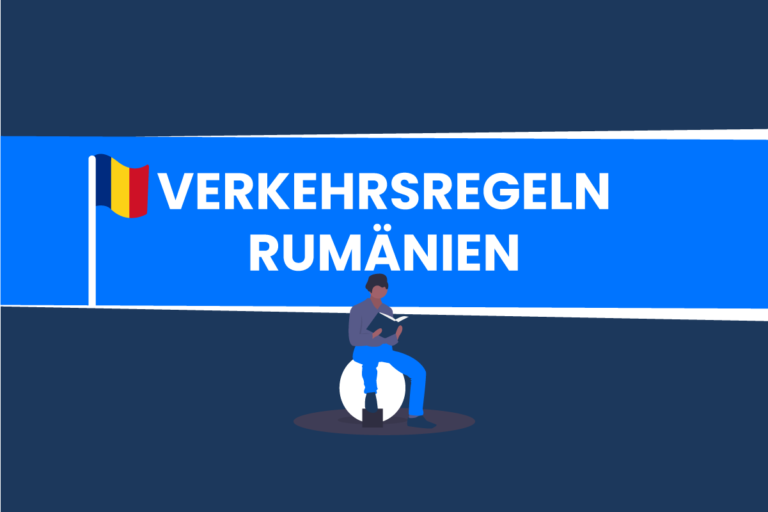Parking Signs In Germany Explained [+Additional Traffic Signs]
When looking for a parking space in Germany, you regularly come across the traffic sign “Parken” with various additional traffic signs. These additional traffic signs change the meaning of traffic sign 314.
In Germany parking spaces are announced or marked with additional traffic signs under traffic sign 314. Additional traffic signs restrict parking to specific types of vehicles, parking discs or residents with parking permits.
Have you always wanted to know which additional traffic signs are attached under the traffic sign “P” and what they mean?
No problem!
This article covers the following combinations:
- Parking with parking ticket sign
- Parking only with parking disc
- Parking only for passenger cars
- Parking only for severely disabled
- And more …
Here we go!
Meaning Of Traffic Sign 314
Parking Without Additional Traffic Signs
Traffic sign 314 allows parking (Annex 3 consecutive number 7 StVO).
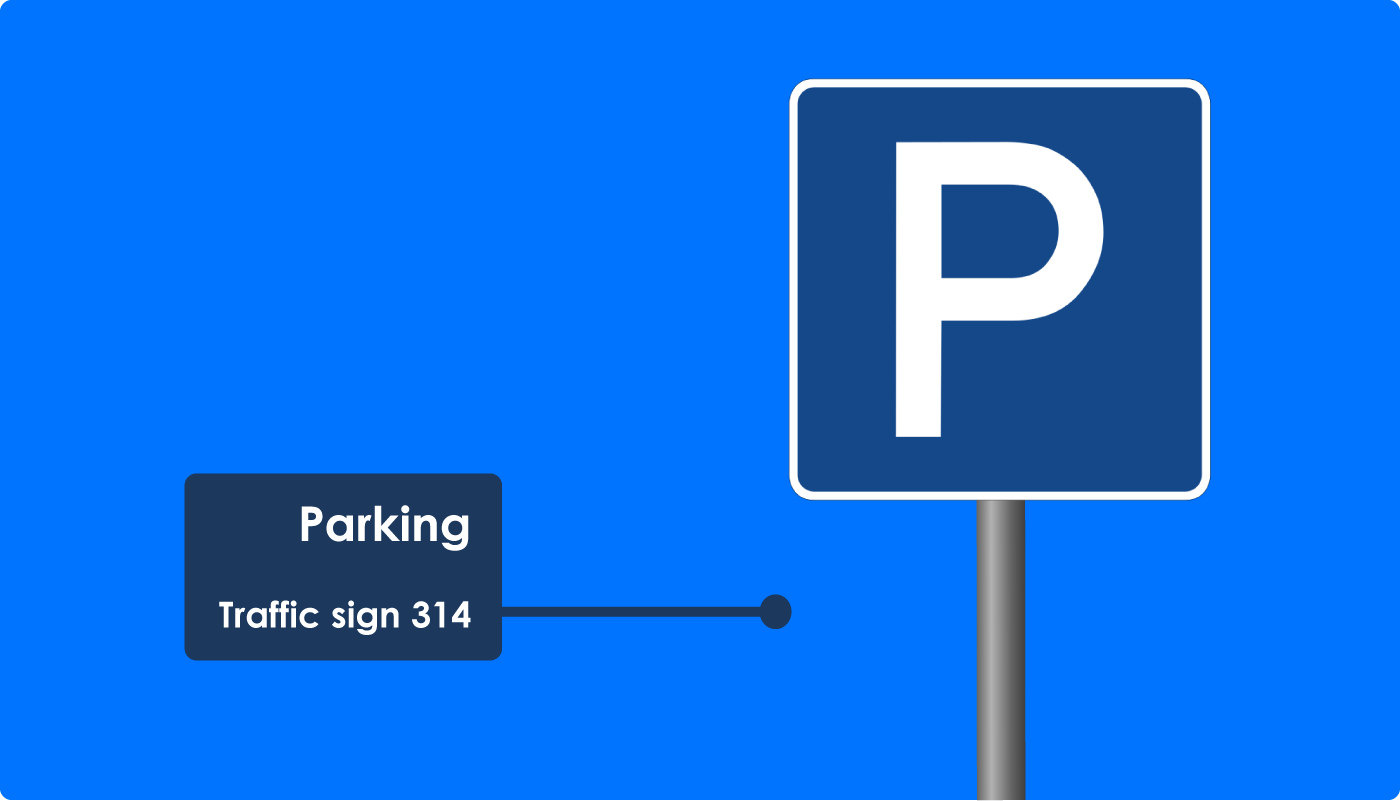
Accordingly, traffic sign 314 designates parking spaces.
Parking spaces marked with sign 314 are not reserved for a specific type of traffic.
That means, for example
- Passenger cars,
- Motorcycles,
- Mopeds,
- Small mopeds,
- Electric vehicles,
- Buses,
- Trucks,
- Bicycles,
- E-bikes or
- Mobile homes
may park in parking spaces that are signposted with a stand-alone traffic sign “Parken”.
If parking area markings are attached at the same time, the order of the parking area markings must be observed (Annex 2, consecutive number 74 StVO).
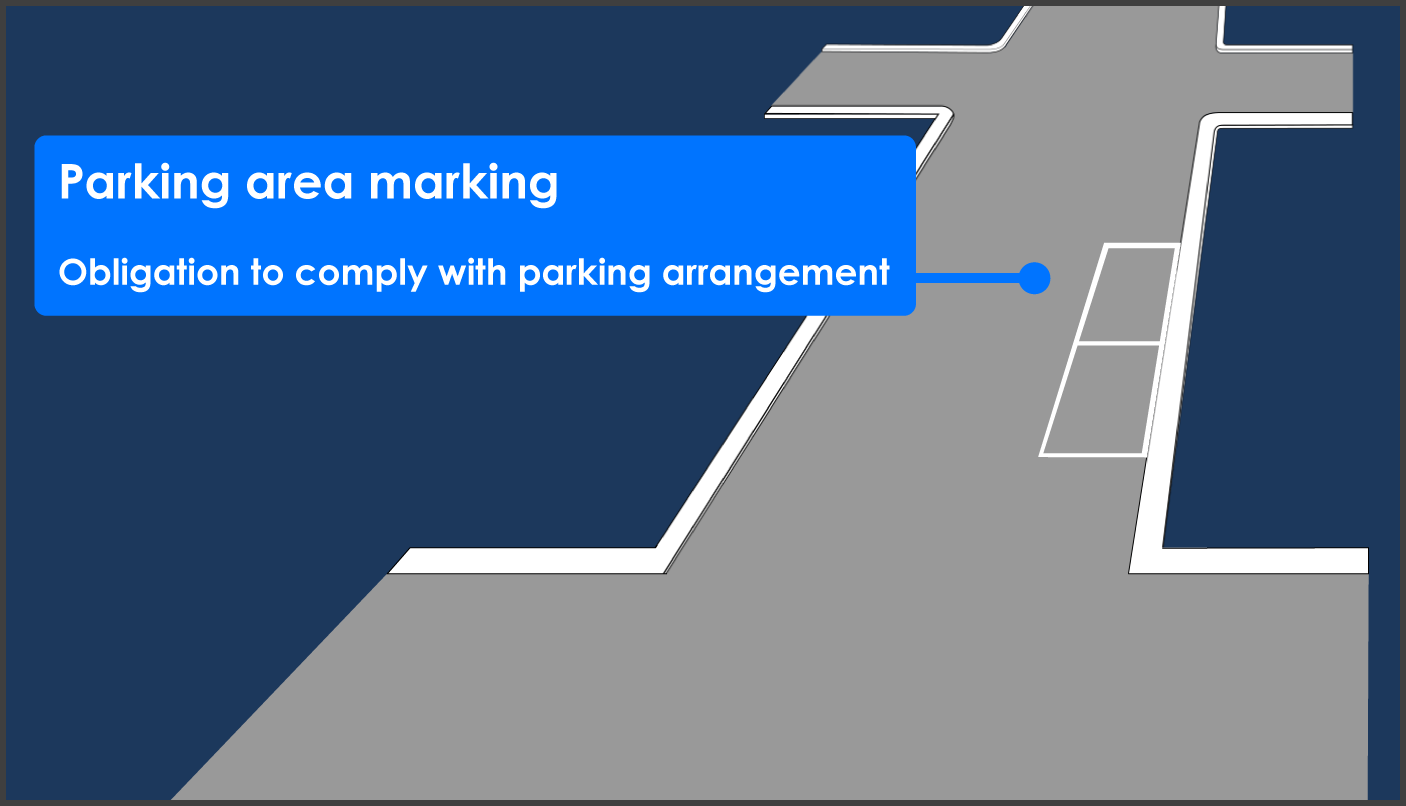
The German Road Traffic Regulations (German: Straßenverkehrs-Ordnung, German abbreviation: StVO) explain parking area markings as follows:
If parking areas on streets are visibly demarcated, this is how vehicles are to be parked.
Annex 2 consecutive number 74 StVO
Alone traffic signs “P” are really only the exceptional case.
For example, traffic signs 314 are placed directly in front of the entrance to parking lots (VwV-StVO on traffic sign 314).
In rare cases, the traffic sign “Parken” (traffic sign 314) indicates permitted parking on hard shoulders or at the edge of the road (VwV-StVO on traffic sign 314).
However, this is only the case if it is not otherwise apparent that parking is permitted there (VwV-StVO on traffic sign 314).
Normally, traffic sign 314 (parking) is placed with an additional sign underneath.
Parking Garage Without Additional Traffic Signs
If the entrance to a parking garage is not clearly recognizable, traffic sign 314 can show you where to get into the parking garage (VwV-StVO on traffic sign 314).
A white roof over traffic sign “P” indicates that it is parking garage (VwV-StVO on traffic sign 314).
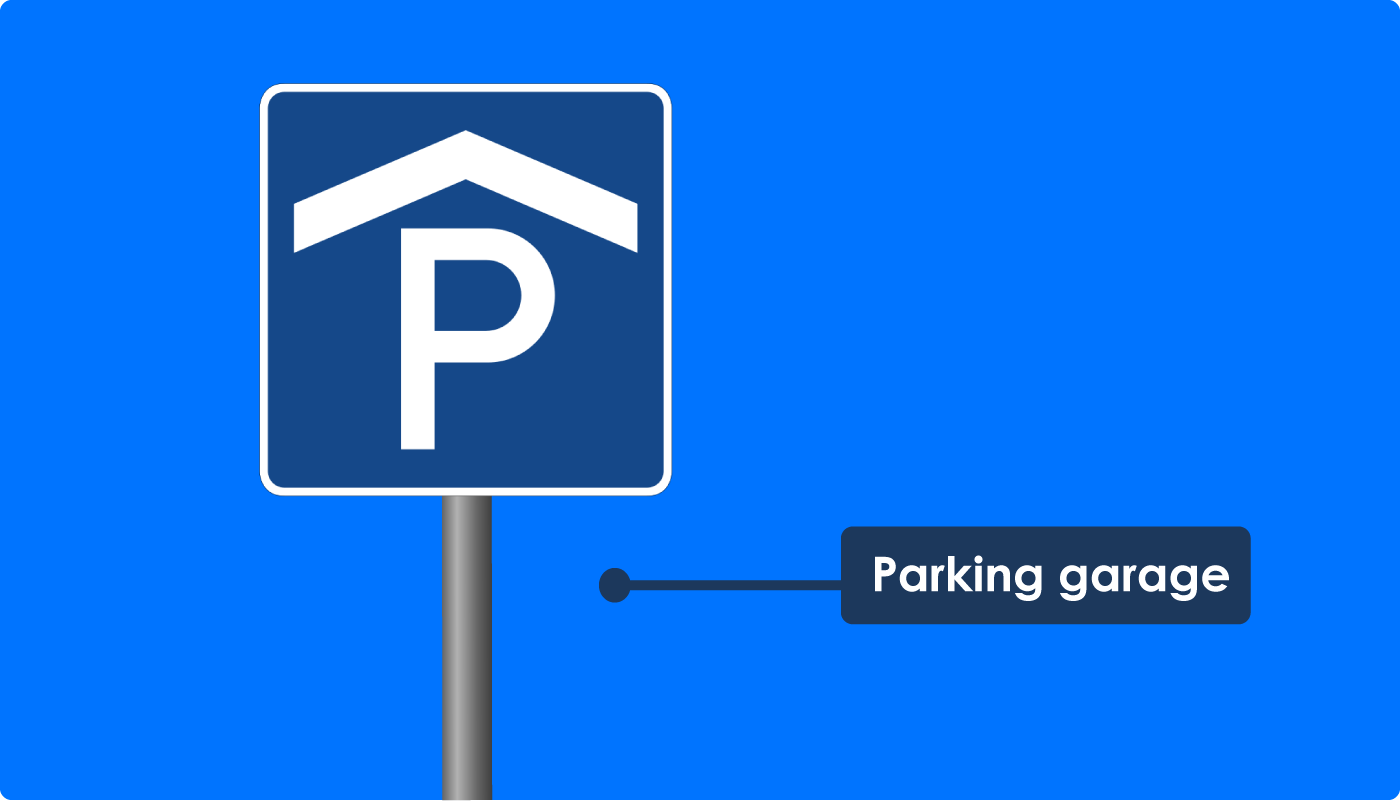
Some parking garages show you whether parking is free or occupied. Other parking garages indicate how many parking spaces are still available (VwV-StVO on traffic sign 314).
Traffic signs 314 are not normally placed in traffic-calmed areas. Exceptionally, you may also encounter traffic sign 314 in a traffic-calmed area. You can find out more about which exceptions there are in the article Traffic-calmed area: Requirements on this website.
Traffic Sign 314 With White Arrows
Traffic signs 314 can also be provided with white arrows.
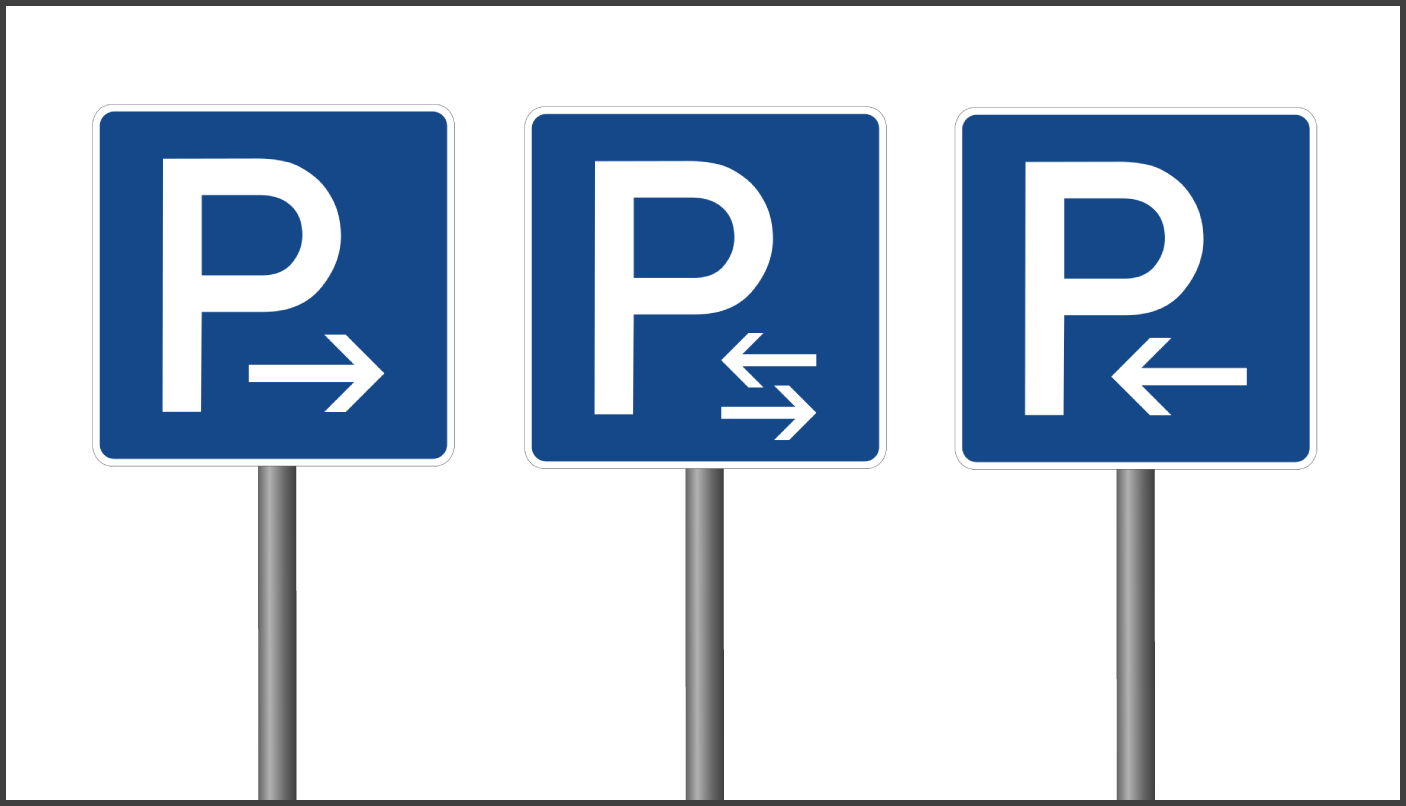
A white arrow on the traffic sign “P” is used to limit parking to a specific section.
The beginning of the parking spaces is indicated by an arrow pointing to the roadway (Annex 3 consecutive number 7 StVO).
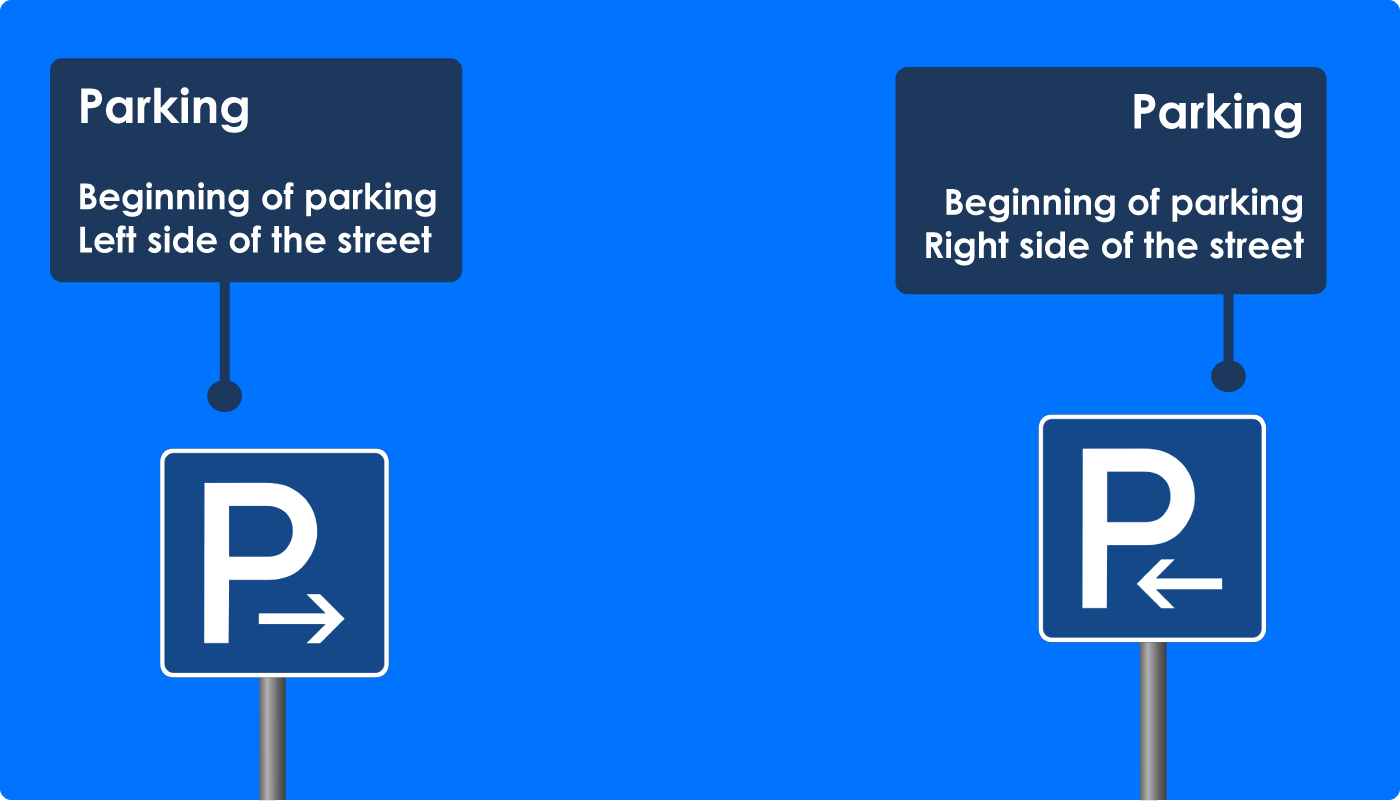
The start of permitted parking can be marked both on the right and on the left side of the road.
The end of the parking area is indicated by an arrow pointing away from the road (Annex 3 consecutive number 7 StVO).
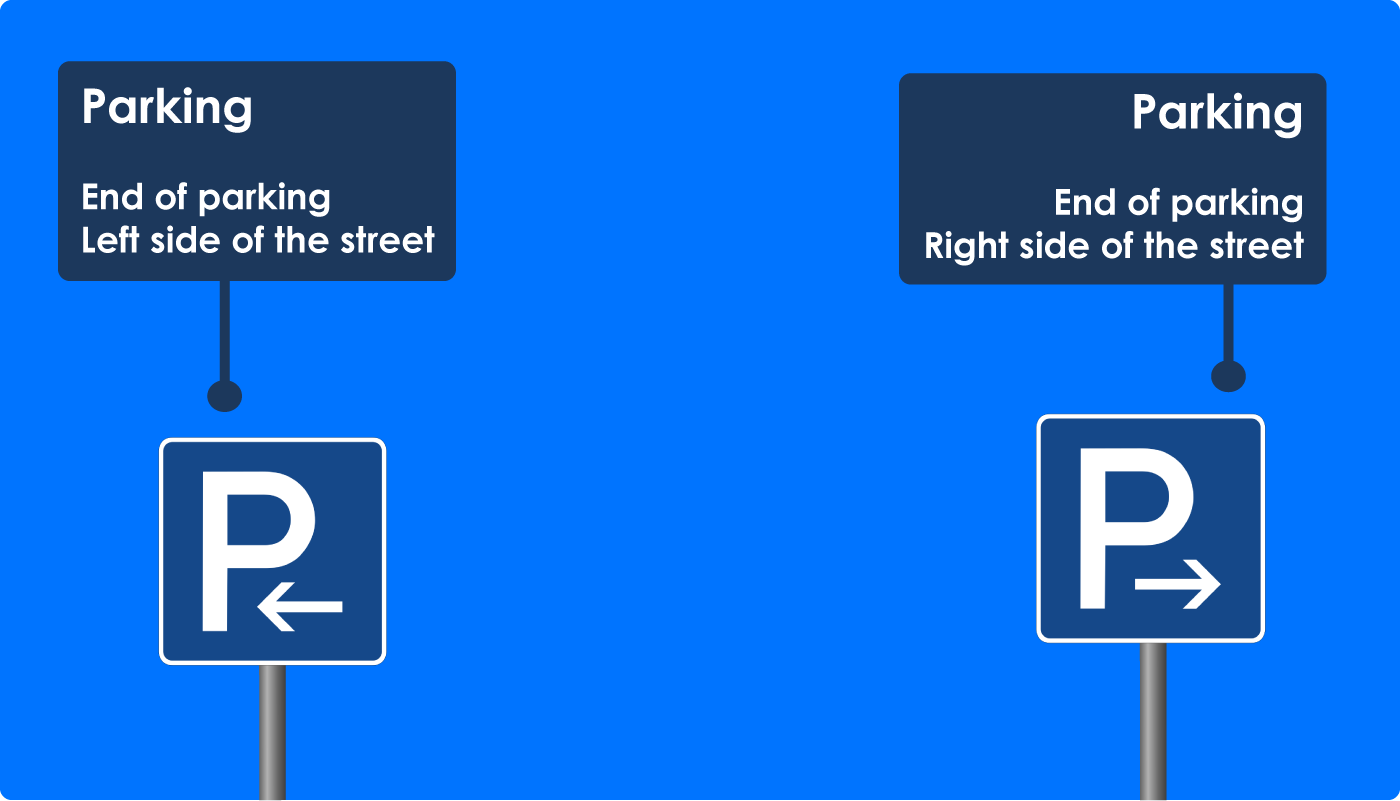
It is also colloquially referred to as the “end of parking”.
Sometimes a whole battery of parking areas is signposted with traffic sign 314. Traffic sign 314, that is to say the message “You can park here”, is then repeated.
One speaks of the center of a parking area.
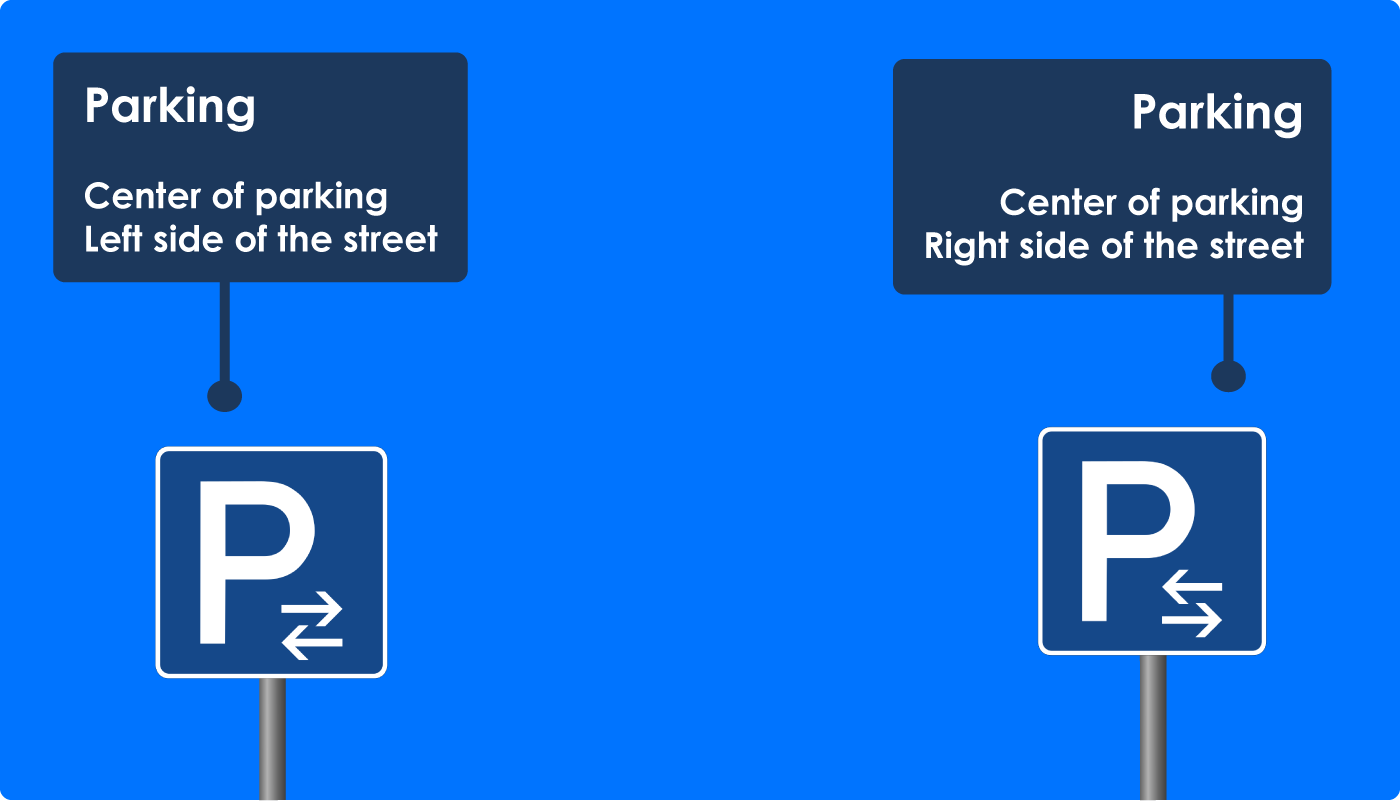
A repetition of traffic sign 314 is provided with two arrows. A white arrow points to the roadway, the other points away from the roadway (Annex 3 consecutive number 7 StVO).
If parking areas are indicated on a long section, it looks like this:
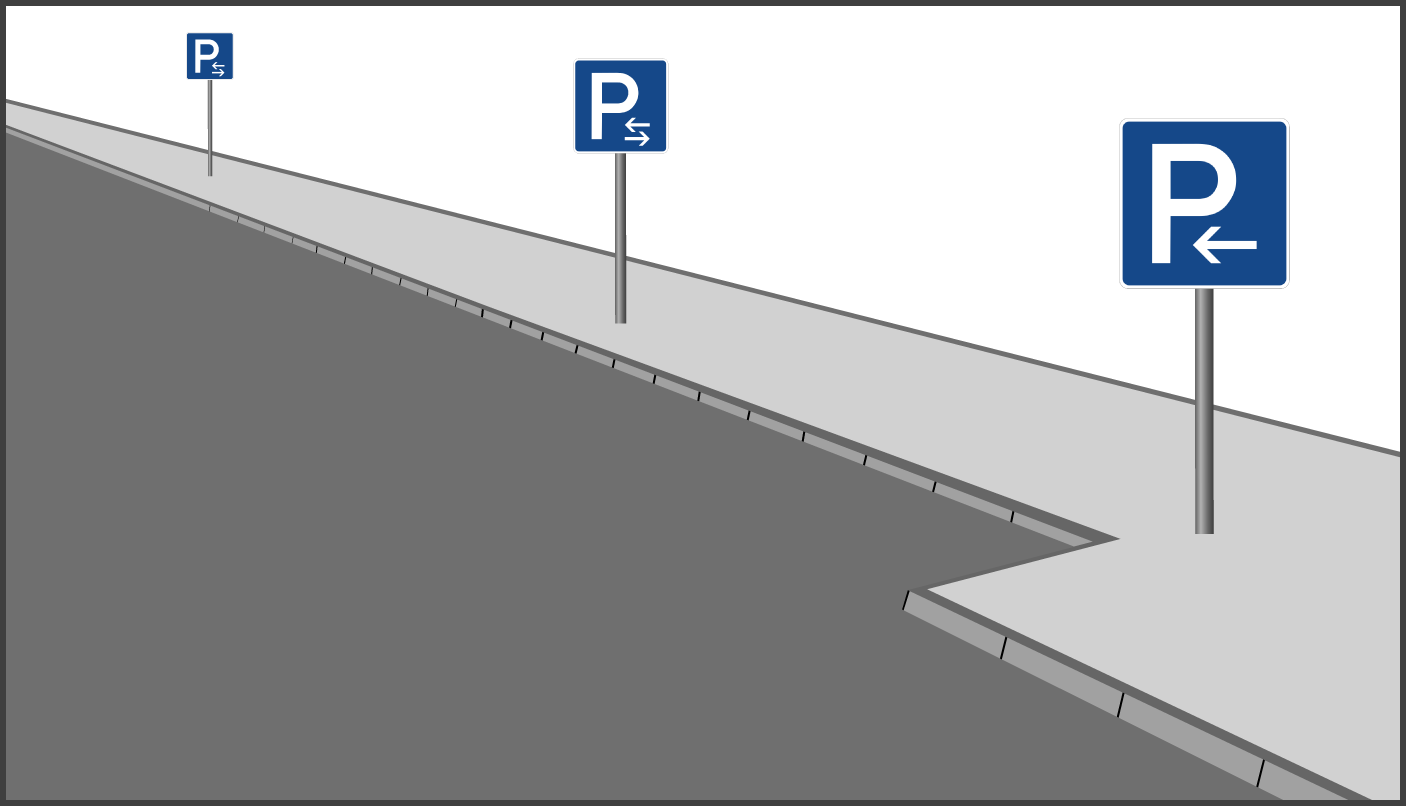
Admittedly, the signage of parking areas with the versions beginning and end without additional traffic signs is very rare in practice.
However, you will often encounter traffic signs “P” with additional traffic signs with a beginning and end.
Parking With Black Arrow
If traffic sign 314 is supplemented with a traffic sign with a black arrow (traffic sign 1000-10, 1000-20), this has nothing to do with the beginning or end of parking areas.
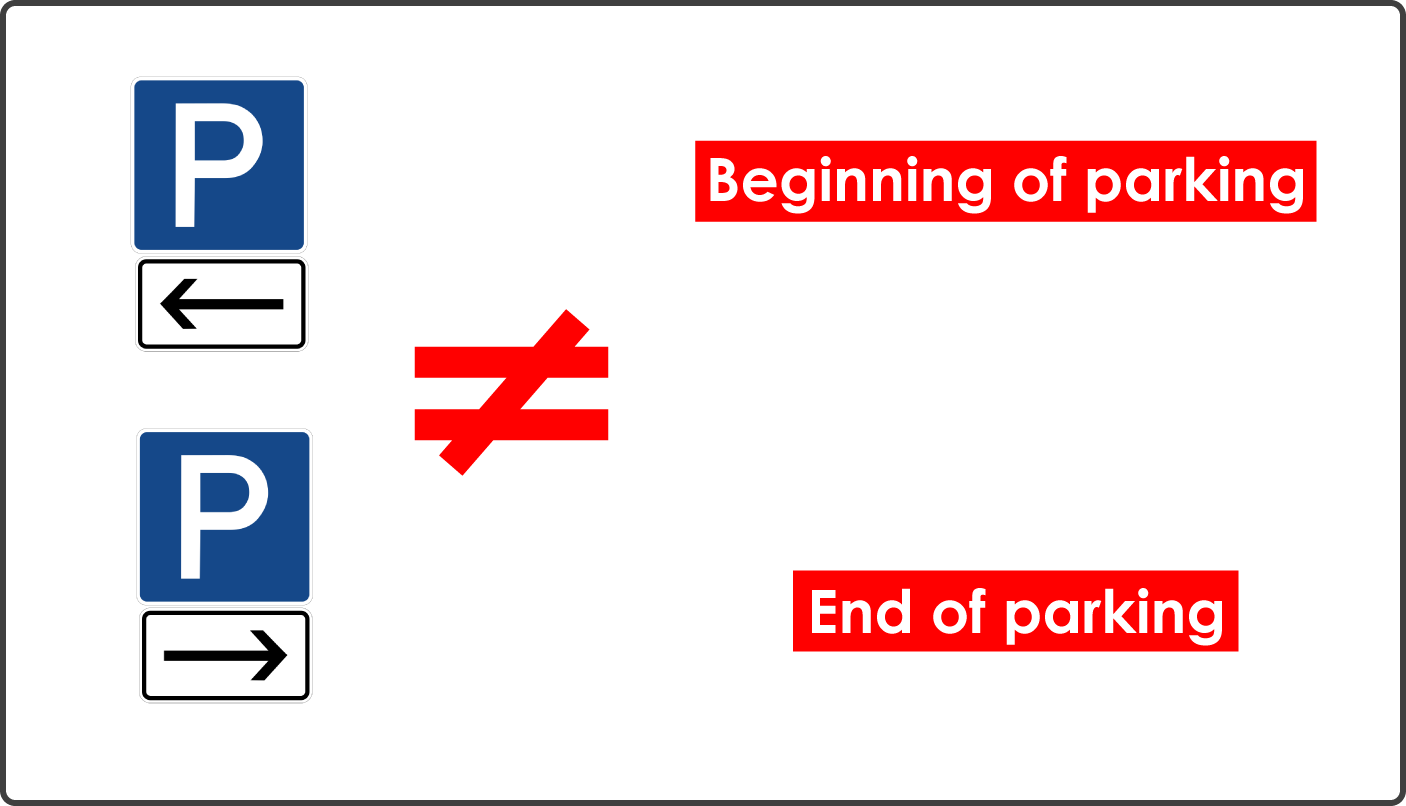
Traffic sign 314 without a white arrow on the blue traffic sign, but with an additional traffic sign showing a black arrow, indicates a driveway to a large car park or a parking garage (Annex 3 consecutive number 7 StVO).
An additional traffic sign with an arrow to the left (traffic sign 1000-10) under traffic sign “P” shows you, for example, that there is a large car park to your left.
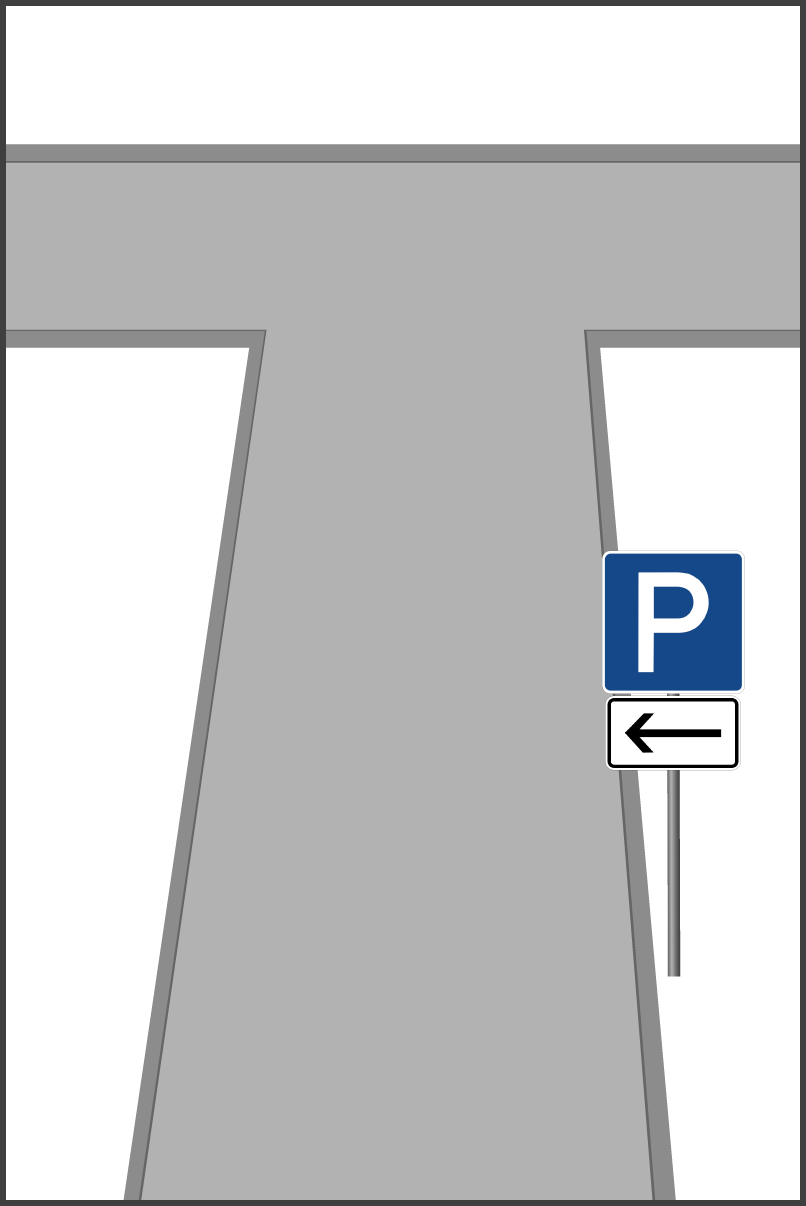
However, whether you will find many free parking lots thereis another matter.
Parking Only With Parking Ticket
In some places, traffic sign 314 is placed with an additional traffic sign that says “mit Parkschein” (traffic sign 1053-31) or with the additional traffic sign “gebührenpflichtig” (traffic sign 1053-32).
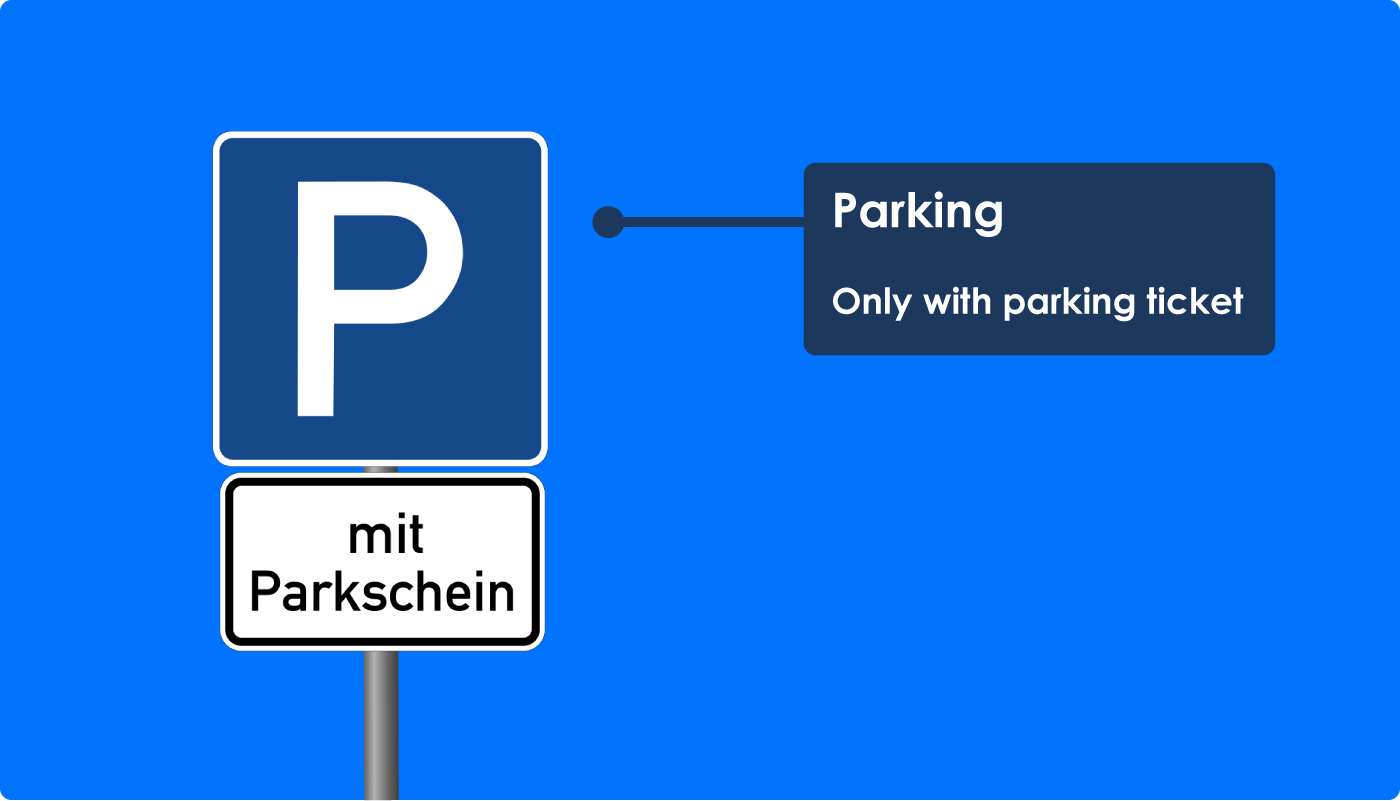
The additional signs “mit Parkschein” (English: “with parking ticket”) or “gebührenpflichtig” (English: “subject to a charge”) tell you that parking ticket machines or parking meters are to be used in the signposted area.
That is why you will find traffic signs 314 with beginning, middle and end at these parking lots. The additional traffic sign “mit Parkschein” or “gebührenpflichtig” is then located under traffic signs 314 with white arrows.
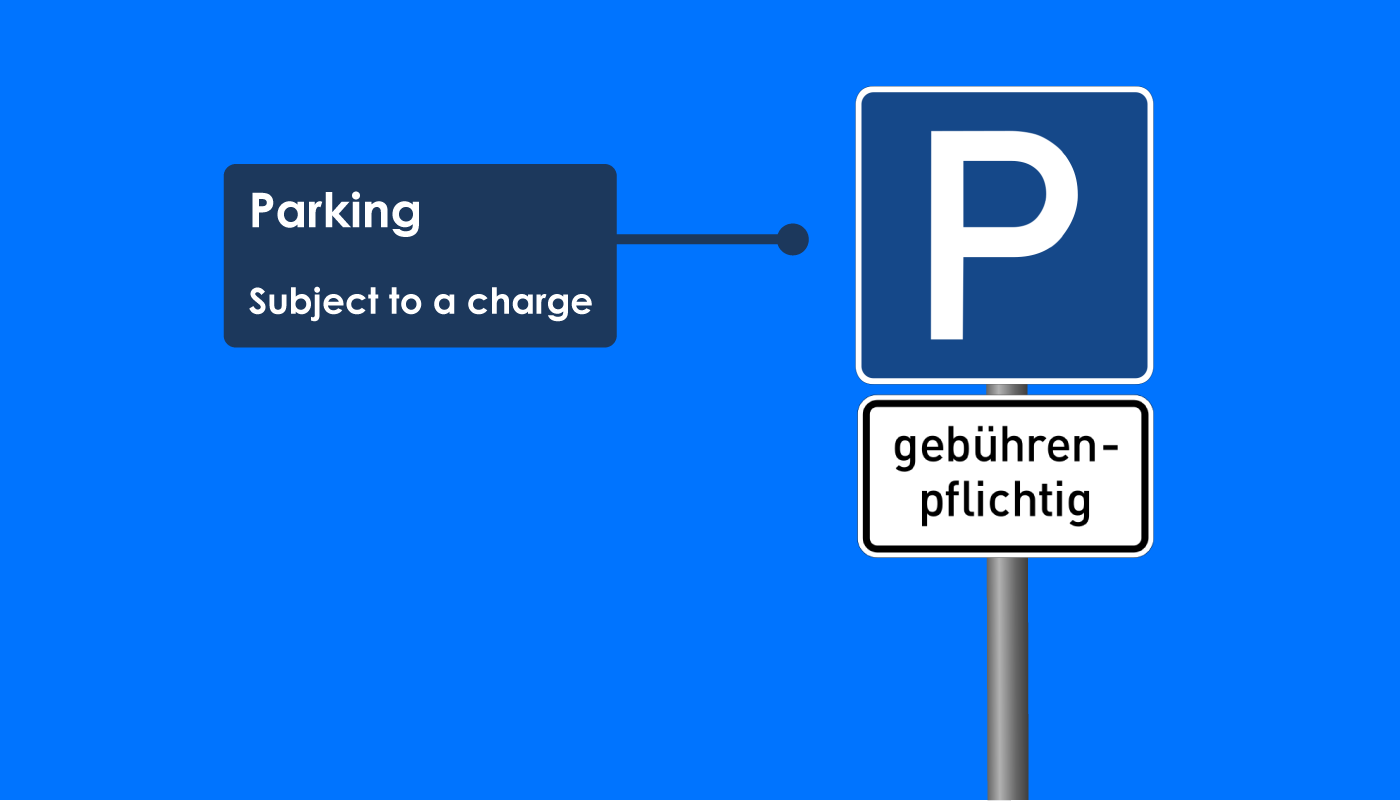
The combination of traffic sign 314 with the additional traffic sign “mit Parkschein” or “gebührenpflichtig” spatially delimits the area. Parking ticket machines or parking meters must be used in this area.
However, the actual regulation regarding the limited parking time results solely from the parking ticket machines and parking meters.
Parking meters may only be parked while the clock is running, parking ticket machines only with a parking ticket, which must be clearly legible on or in the vehicle from the outside, for the duration of the permitted parking time.
section 13, paragraph 1 StVO
It’s best if we break it down:
At parking meters, you may stop if they are running.
You may only stop at parking ticket machines for the permitted parking time if you have a parking ticket that is clearly legible from the outside.
“Wait, I just read you may stop,” you’re probably asking yourself right now.
To be honest: That was on purpose. In fact, the StVO initially speaks of stopping at parking meters and parking ticket machines.
Regarding stopping the StVO says:
If you […] stop for more than three minutes, you park.
section 12, paragraph 2 StVO
At parking ticket machines, you could ask yourself whether you are only allowed to stop at them for three minutes – with a parking ticket.
But it could just as well mean that you can only stop at parking ticket machines if you are willing to buy a parking ticket.
However, that would mean that you are only allowed to park at parking ticket machines. Stopping would then not be allowed at all at parking ticket machines.
Let’s assume there is an editorial error here.
Fact is that in most cases, after throwing in a few pieces of metal you stop at parking meters and parking ticket machines for more than three minutes. That means in these cases you park.
Parking meters and ticket machines may be limited to specific hours or days.
The use of parking meters and parking ticket machines is of course only possible if they work.
If the parking meter or parking ticket machine of your choice is broken, you will ask yourself: what to do now?
The StVO also has the answer. The following applies to broken parking meters or parking ticket machines:
Parking is only allowed up to the specified maximum parking time. A parking disc must be displayed for this purpose (section 13, paragraph 1 StVO).
Parking Only Within A Certain Time
Traffic sign 314 may also be placed with an additional traffic sign restricting parking to a specific time.
For example, parking can be limited to the period from 4 pm to 6 pm (traffic sign 1040-30).
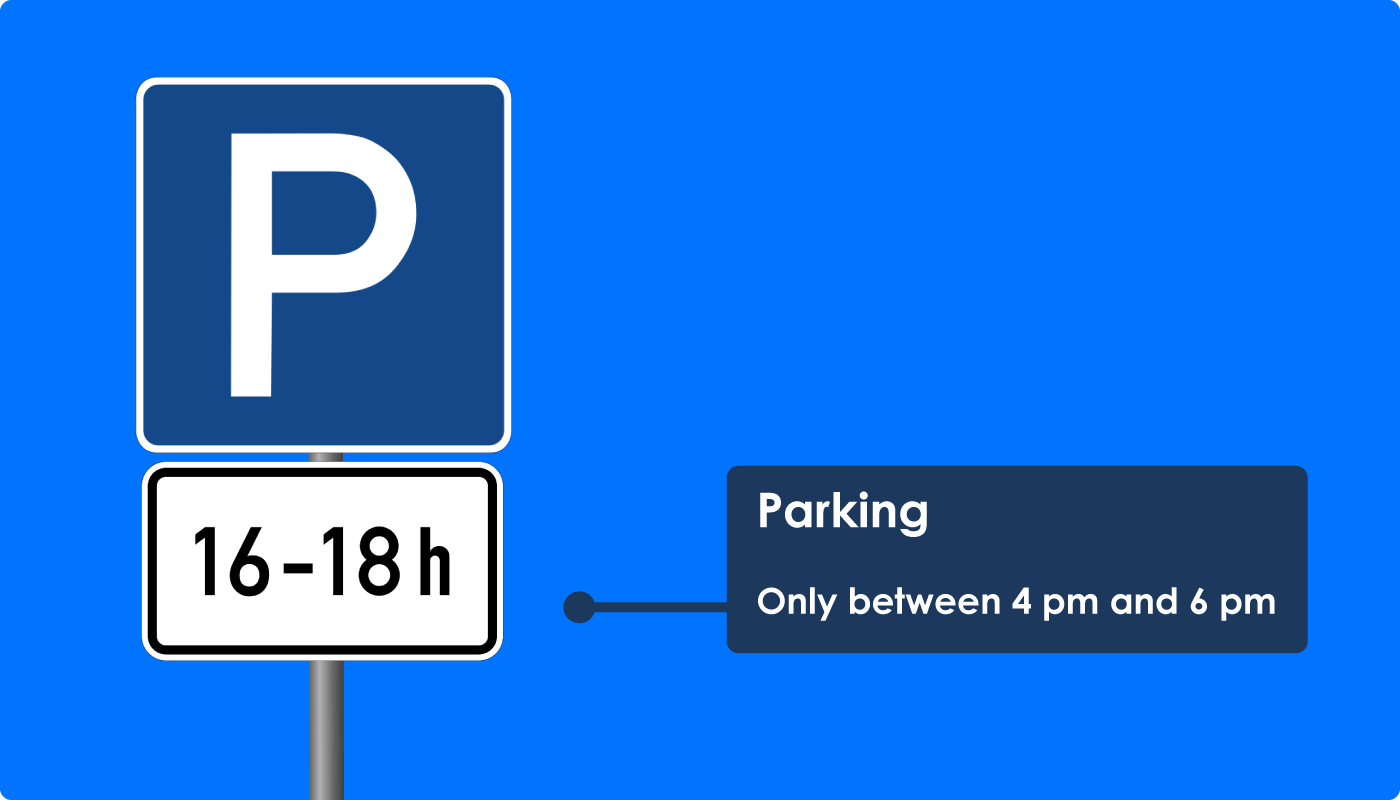
Likewise, parking spaces can also be limited to two periods.
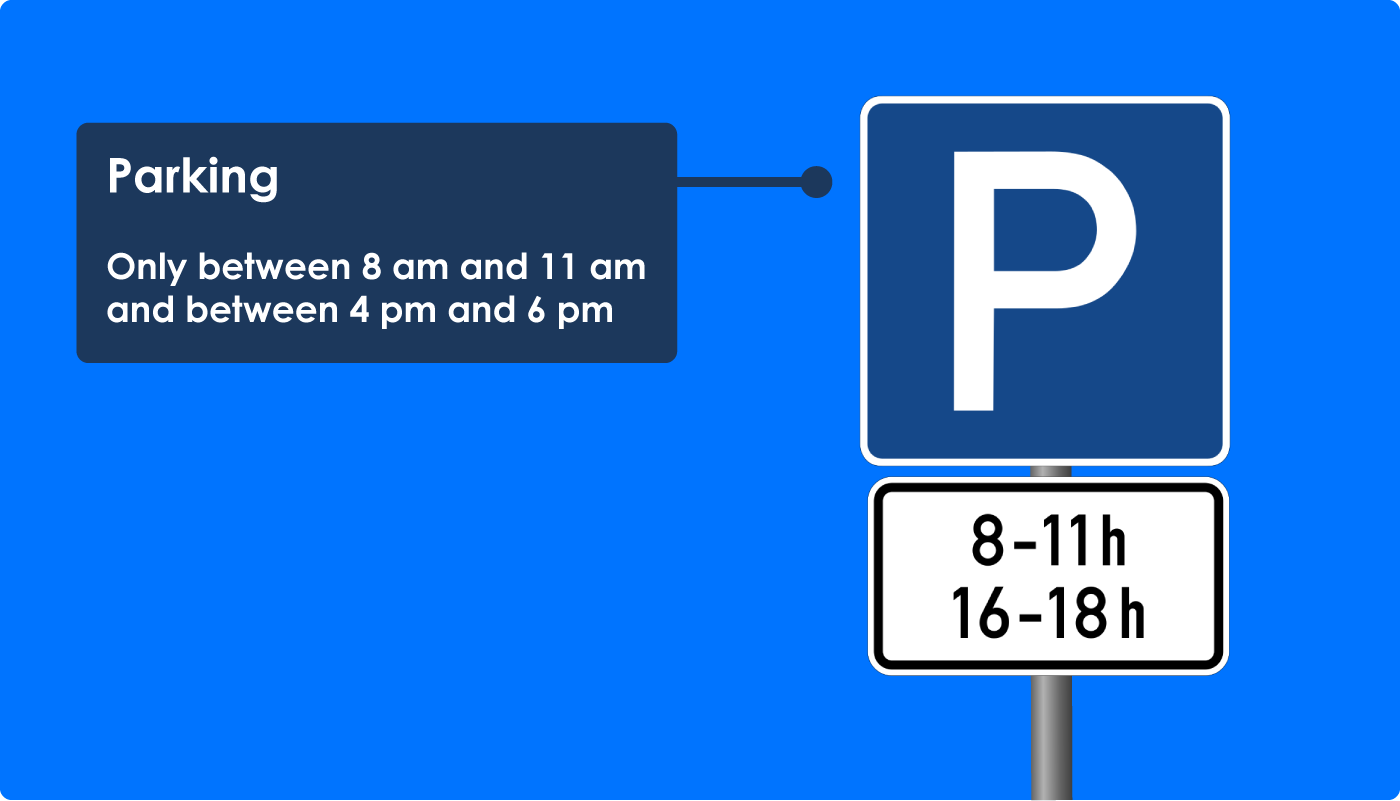
Parking is permitted in these car parks from 8 am to 11 am and from 4 pm to 6 pm (traffic sign 1040-31).
Parking Only On Certain Weekdays
In addition to a time restriction, parking may be restricted to certain days of the week.
For this reason, you can also encounter a traffic sign 314 with an additional traffic sign with the inscription “werktags” (traffic sign 1042-30) or “Mo-Fr 16-18 h” (traffic sign 1042-33).
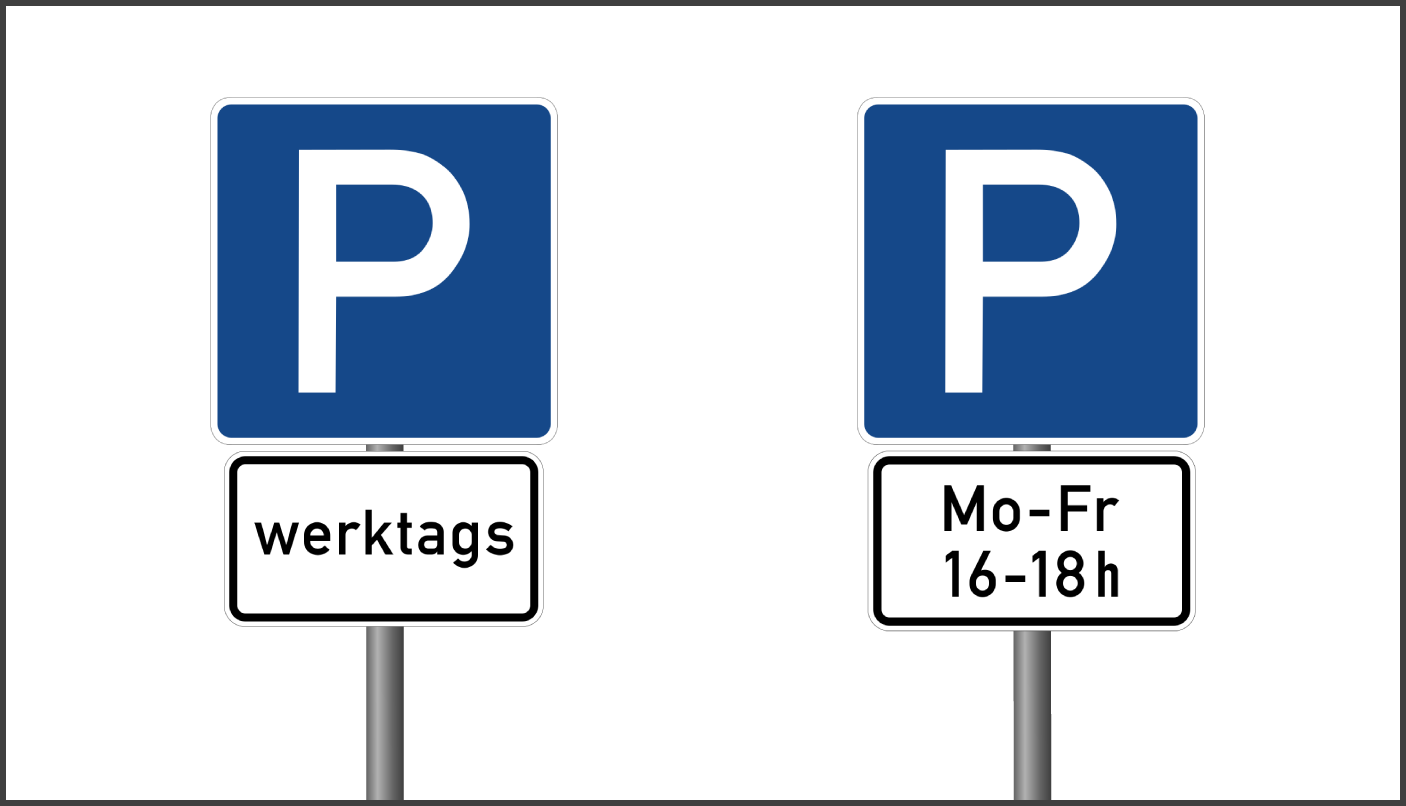
The inscription “werktags” stands for working days. Holidays are not working days. You can find out which dates belong to public holidays in Germany in chapter “No waiting” sign: working days.
On a public holiday, parking is therefore not permitted in car parks marked with traffic sign 314 and the additional traffic sign “werktags”.
Saturdays count as working days (OLG Hamburg, judgement of 16 February 1984 – 1 Ss 14/84 OWi; OLG Düsseldorf, judgement of 5 December 1990 – 2 Ss (OWi) 332/90 – 83/90 II, NZV 1991, 402; OLG Hamm, judgement of 7 March 2001 – 2 Ss OWi 127/01, NZV 2001, 355 = WKRS 2001, 17370; BGH, judgement of 27 April 2005 – VIII ZR 206/04, openJur 2012, 59101).
With the combination of traffic sign 314 and the additional traffic sign “werktags außer samstags” (traffic sign 1042-38), parking is not only prohibited on working days, but also not permitted on Saturdays.
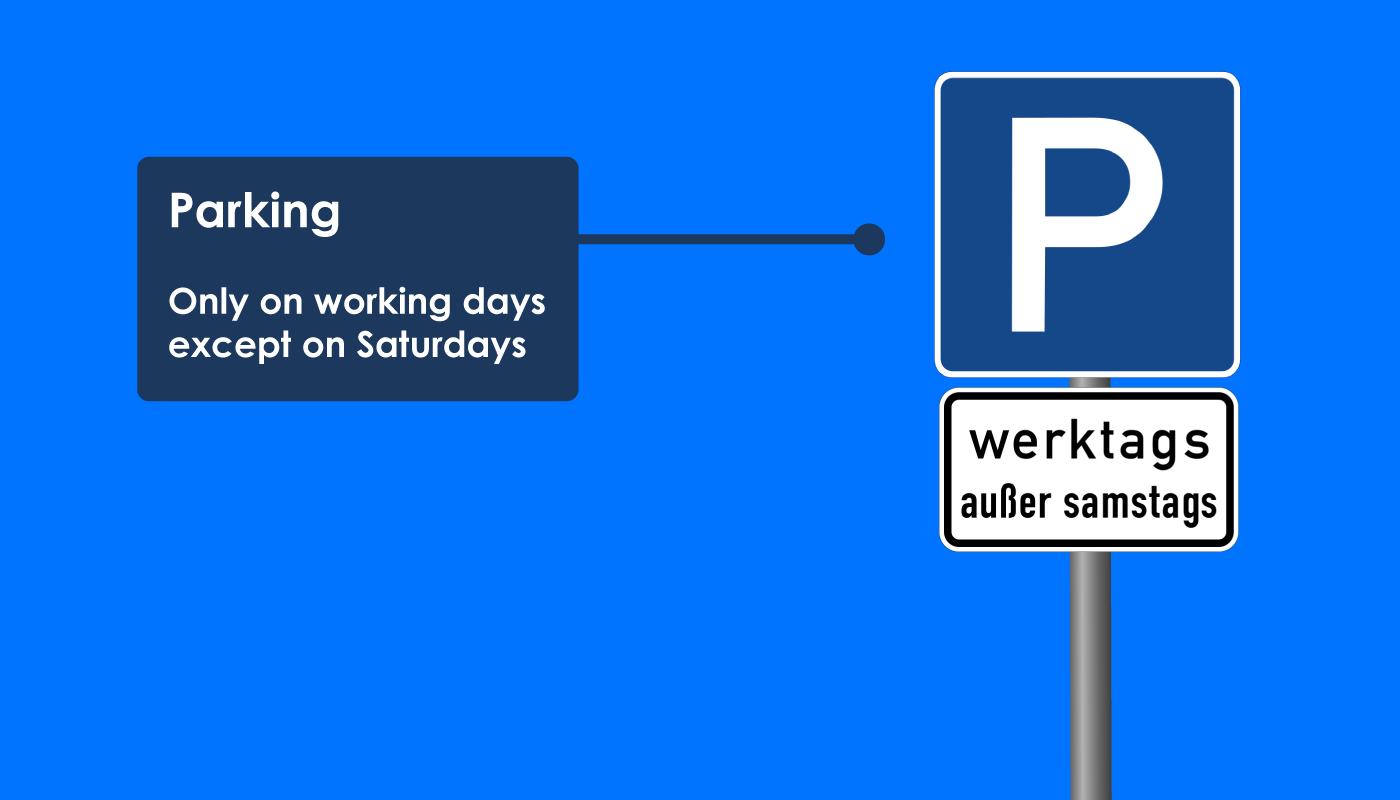
It is also not allowed to park on a public holiday that falls on a working day between Monday and Friday.
Traffic sign 314 with the additional traffic sign “Mo-Fr” restricts parking to the period from Monday to Friday. Whether a public holiday falls on a day between Monday and Friday is irrelevant. On public holidays between Monday and Friday, parking is also permitted for the combination of traffic sign 314 with the additional traffic sign “Mo-Fr”.
Traffic sign 314 with additional traffic sign “werktags” restricts parking from Monday to Saturday; this excludes public holidays. On public holidays, parking is not permitted between Monday and Saturday in parking areas marked with traffic sign 314 and the additional traffic sign “werktags”.
An additional traffic sign with the inscription “Mo-Fr Sa” or “Mo-Sa” is not included in the traffic sign catalogue. It is questionable whether such additional traffic signs are permissible and have a regulatory effect. Hence my interpretation of the traffic sign 314 with additional traffic sign “Mo-Sa”:
Traffic sign 314 with additional traffic sign “Mo-Sa” should restrict parking from Monday to Saturday. This should also apply if a public holiday falls on a day between Monday and Saturday. On a public holiday, parking in car parks with traffic sign 314 with the additional traffic sign “Mo-Sa” would also be permitted.
Parking Only With Parking Disc
“Parken mit Parkscheibe” may only be combined with four traffic signs (VwV-StVO on section 13, paragraph 2):
- “Haltverbotszone” (traffic sign 290.1)
- “Parkraumbewirtschaftungszone” (traffic sign 314.1)
- “Parken” (traffic sign 314)
- “Parken auf Gehwegen” (traffic sign 315)
You may only park with a parking disc in parking areas with a combination of traffic sign 314 with additional traffic sign “Image 318”.
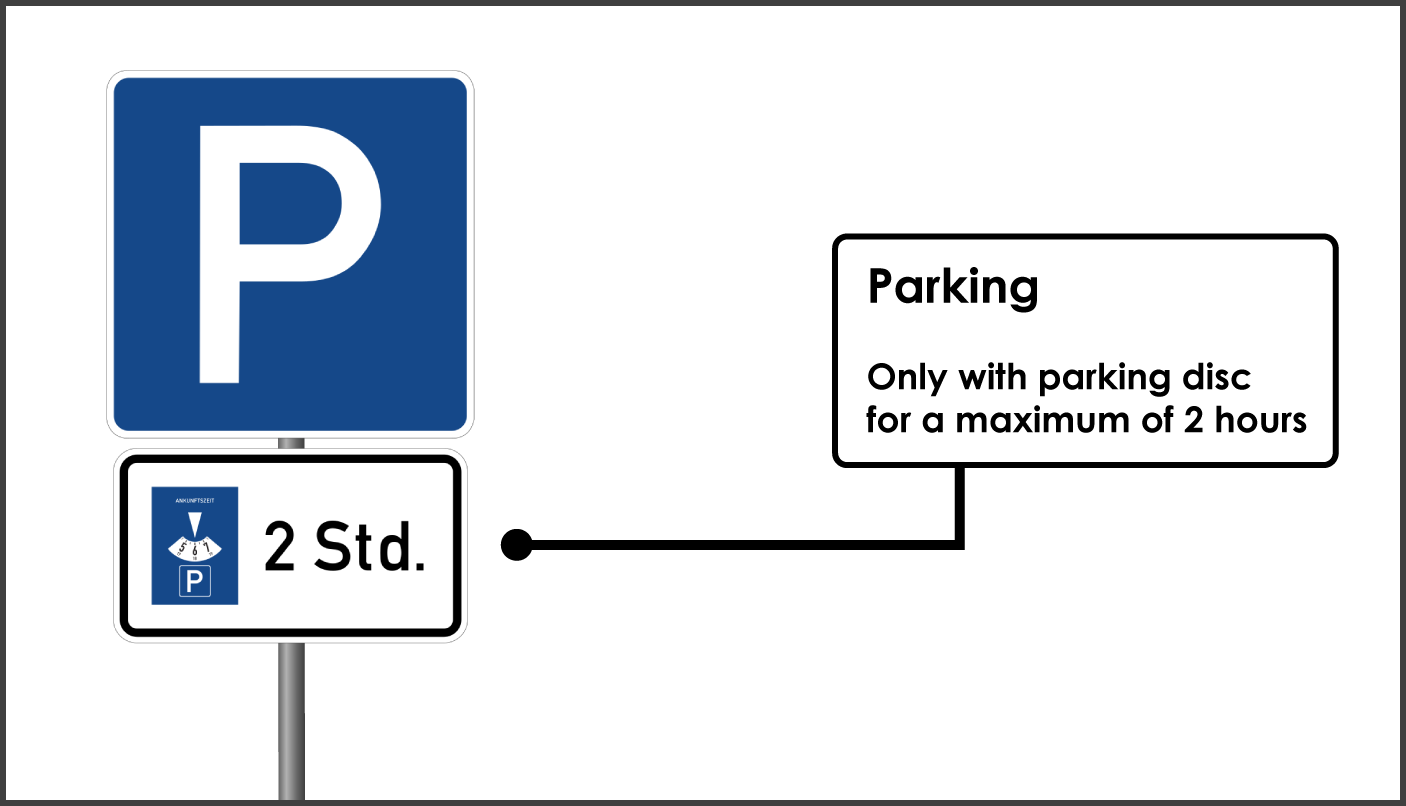
For parking spaces with the combination “Parken” and the additional traffic sign “Image 318” you must display your parking disc so that it is easy to read from the outside. You can set the pointer on the disc to the line of the half hour that follows the time of stopping (section 13, paragraph 2 StVO).
The additional traffic sign with a parking disc (traffic sign 318) shows you the maximum parking time in hours (Annex 3 consecutive number 7 StVO).
Parking with a parking disc can also be limited to a certain period of time.
You may only park at this point for as long as the additional traffic sign prescribes (section 13, paragraph 2 StVO).
Parking Only With Parking Disc And Within Certain Time
If a time is specified on the additional traffic sign “Parkscheibe” in addition to the maximum parking time in hours, the specified maximum parking time in hours only has to be observed during this period.
With the combination of the parking traffic sign and the additional traffic sign “Parkscheibe” as well as the additions “2 Std.” and “8-18 h”, a parking disc is to be displayed between 8 am and 6 pm for parking in the marked parking areas.
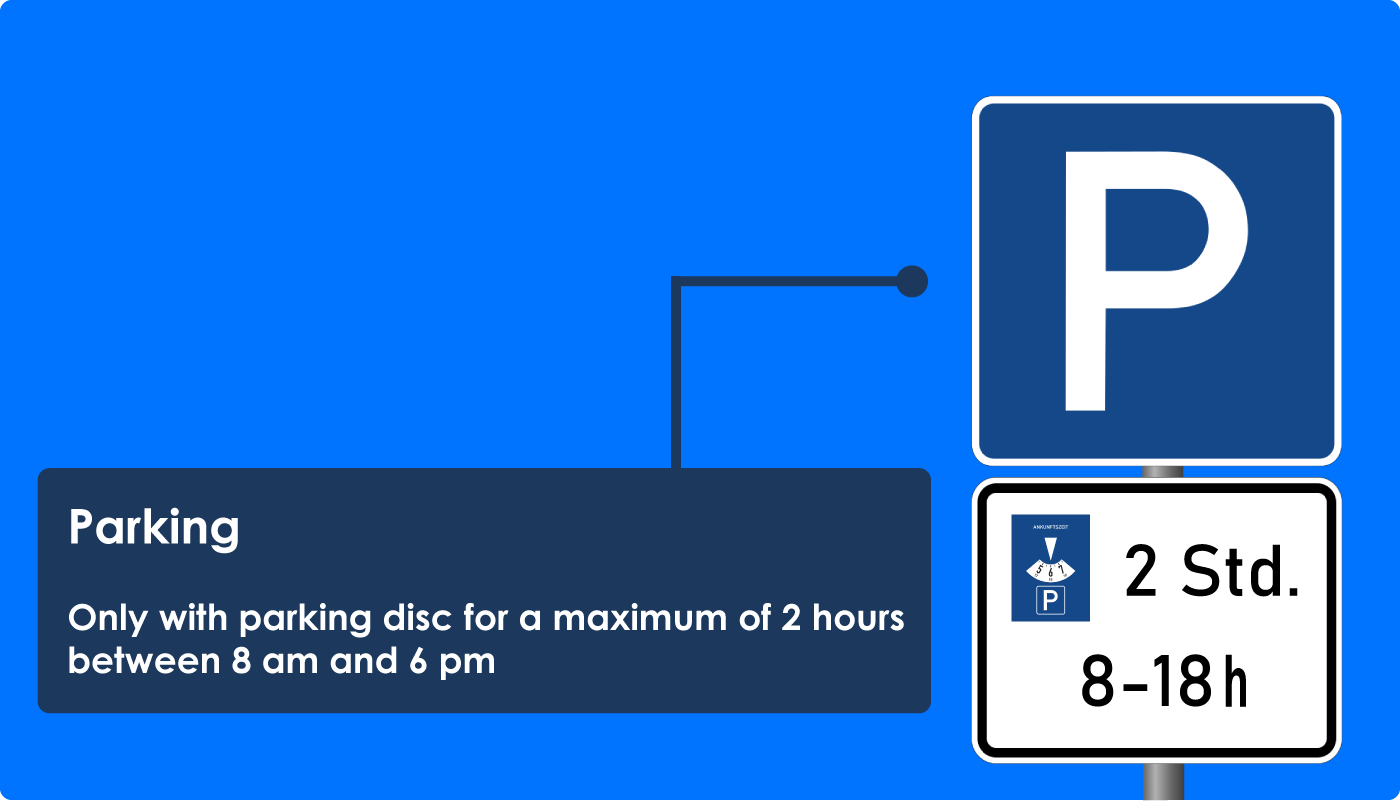
Furthermore, between 8 am and 6 pm you may park for a maximum of 2 hours with a displayed parking disc.
Outside this period, parking is unrestricted.
This means that no parking disc has to be displayed from 6 pm to 8 am the following day. At the same time, unrestricted parking is permitted in the marked parking areas from 6 pm to 8 am the following day.
From 8 am, however, the obligation to display a parking disc applies again.
Parking Only With Parking Disc And On Certain Working Days
With the combination of traffic signs in the picture below, a parking disc must be displayed from 8 am to 7 pm on working days for parking in the marked parking spaces.
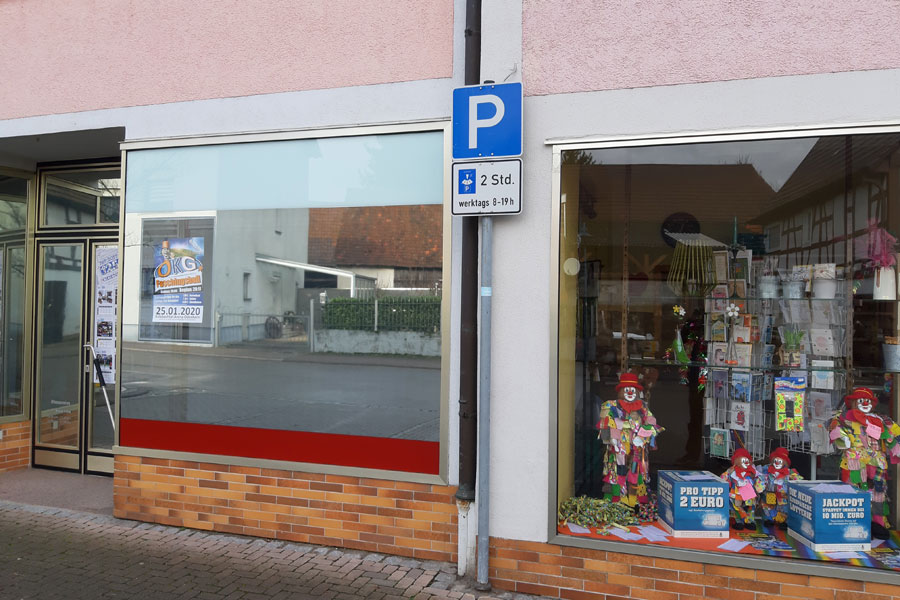
Within this period, you can park for two hours with a parking disc.
Conversely, this means that you can park indefinitely in the marked parking spaces between 7 pm and 8 am without displaying a parking disc.
Parking Only With Parking Disc For Less Than An Hour
In practice, periods of less than an hour are sometimes noted on the additional traffic sign “parking disc”. Whether this is permissible is disputed.
The pointer of a parking disc can only be set to the mark of a full or half hour (section 13, paragraph 2 StVO).
Periods of less than half an hour should therefore hardly be monitorable.
Parking Only For Residents With Parking Permit
Resident Parking Lot Signage
Nowadays, you will often come across resident parking spaces with traffic sign 286 or 290.1 and the additional traffic sign “Bewohner mit Parkausweis … frei” (VwV-StVO on section 45, paragraph 1 to 1e).
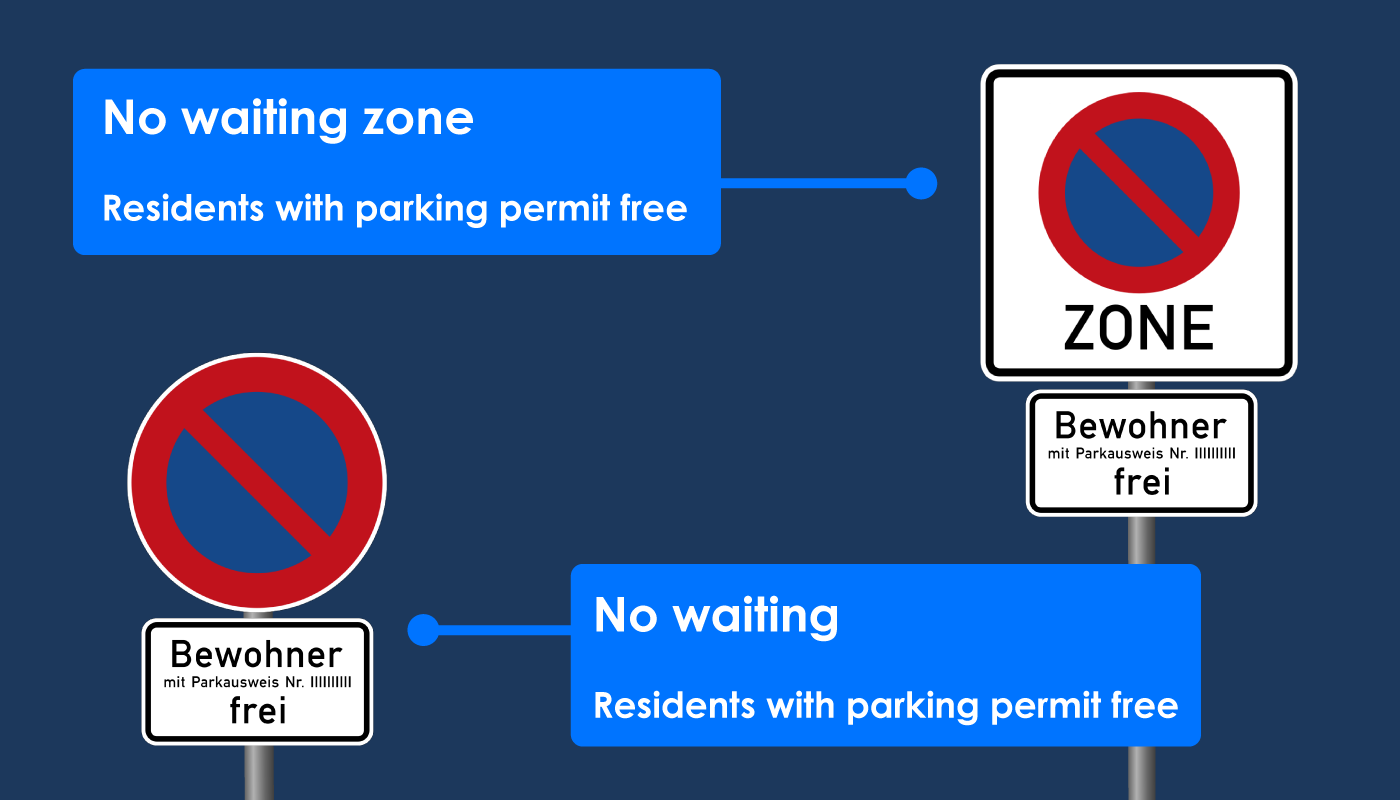
However, the old signage is still valid. Traffic sign 314 and an additional traffic sign “Bewohner mit Parkausweis Nr. …” (traffic sign 1044-30) also limit the parking space for residents (VwV-StVO on section 45, paragraph 1 to 1e).
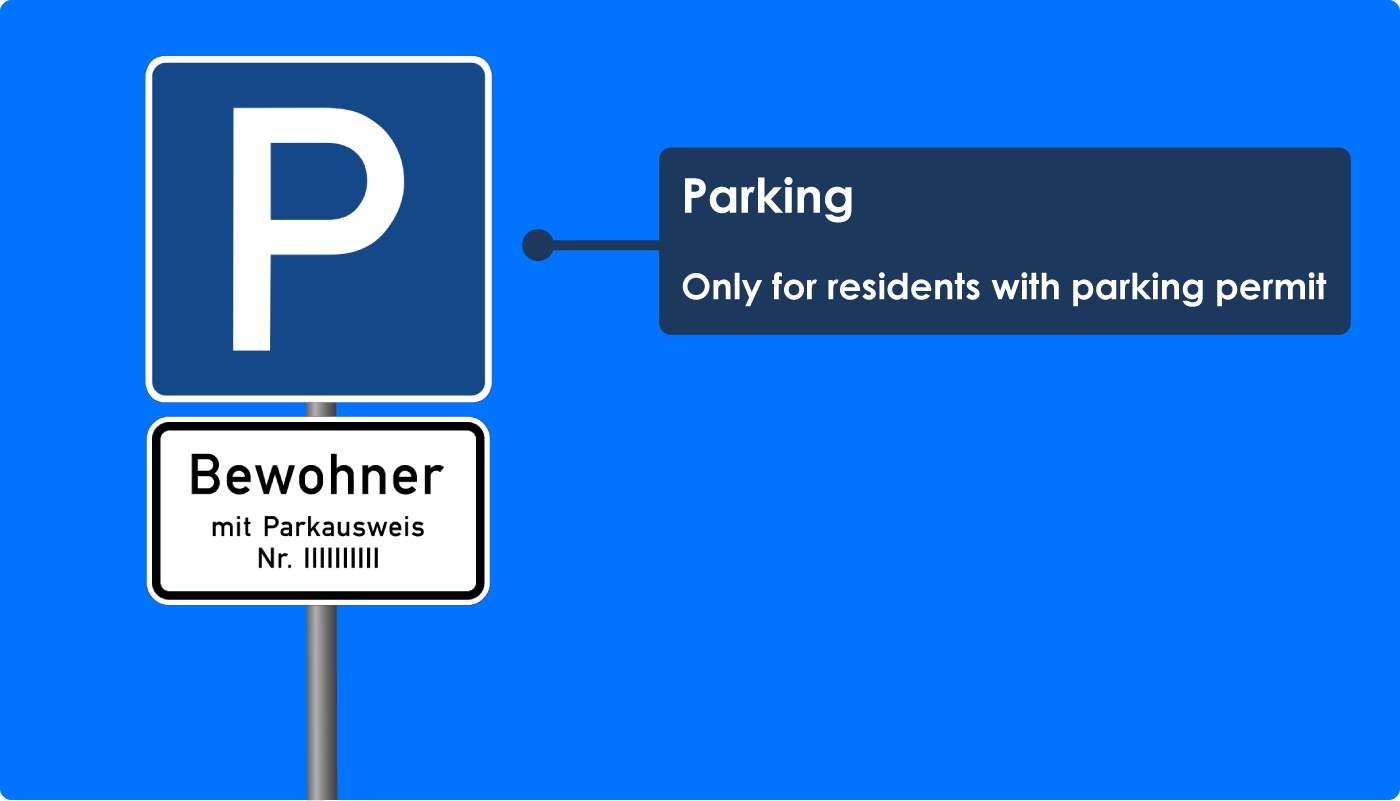
This means that only residents with a special parking permit are allowed to park their vehicles in these parking lots.
Sometimes there are also areas where resident parking privileges are divided into different areas.
You can recognize this by the fact that the additional characters under the main traffic signs 286, 290.1 or “Parken” contain different letters or numbers (VwV-StVO to section 45, paragraph 1 to 1e).
For example, your parking permit for area D will not be of any use in area C.
You may be wondering, under what conditions resident parking spaces are set up at all. I have already devoted an article to this question under the aforementioned link.
Resident Parking Permit Requirements
How do I get a resident parking permit?
Such a resident parking permit does not fall from the sky. Nor will anyone knock on your front door and ask you if you would like one. You have to take action yourself and submit an application to the road traffic authority responsible for you (VwV-StVO on section 45, paragraph 1 to 1e).
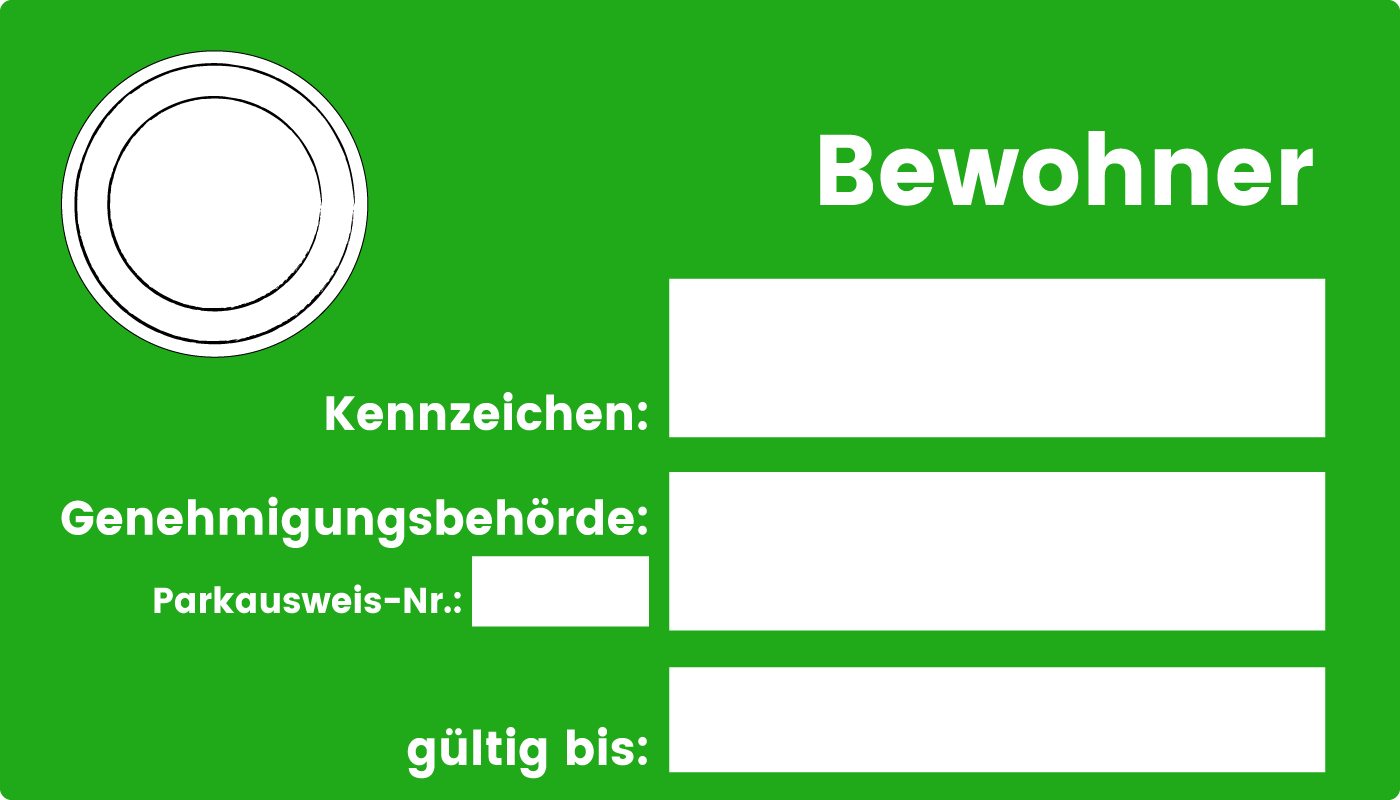
Joking aside. When are you eligible to apply?
First of all, you have to be registered in the relevant area and actually live there (VwV-StVO on section 45, paragraph 1 to 1e).
If you only work in the area in question without living there, you are not a resident and therefore not entitled to claim (BVerwG, judgement of 28 September 1994 – 11 C 24.93).
As a professional who does not live locally, you cannot apply for a parking permit for residents.
The road traffic authority decides together with the responsible city whether a secondary residence is sufficient (VwV-StVO on section 45, paragraph 1 to 1e).
You can only get one parking permit. This parking permit is usually issued on a number plate. The number plate of your vehicle registered in your name is on your parking permit (VwV-StVO on section 45, paragraph 1 to 1e).
Alternatively, the number plate of a vehicle that you can prove that you use permanently can be entered on the parking permit (VwV-StVO on section 45, paragraph 1 to 1e).
As an exception, several number plates or the entry “wechselnde Fahrzeuge” can be stored on the parking permit (VwV-StVO on section 45, paragraph 1 to 1e). But there has to be a really good reason for that.
Do you use car sharing?
You can also apply for a resident parking permit here. The name of your car sharing organization will appear on your parking permit (VwV-StVO on section 45, paragraph 1 to 1e).
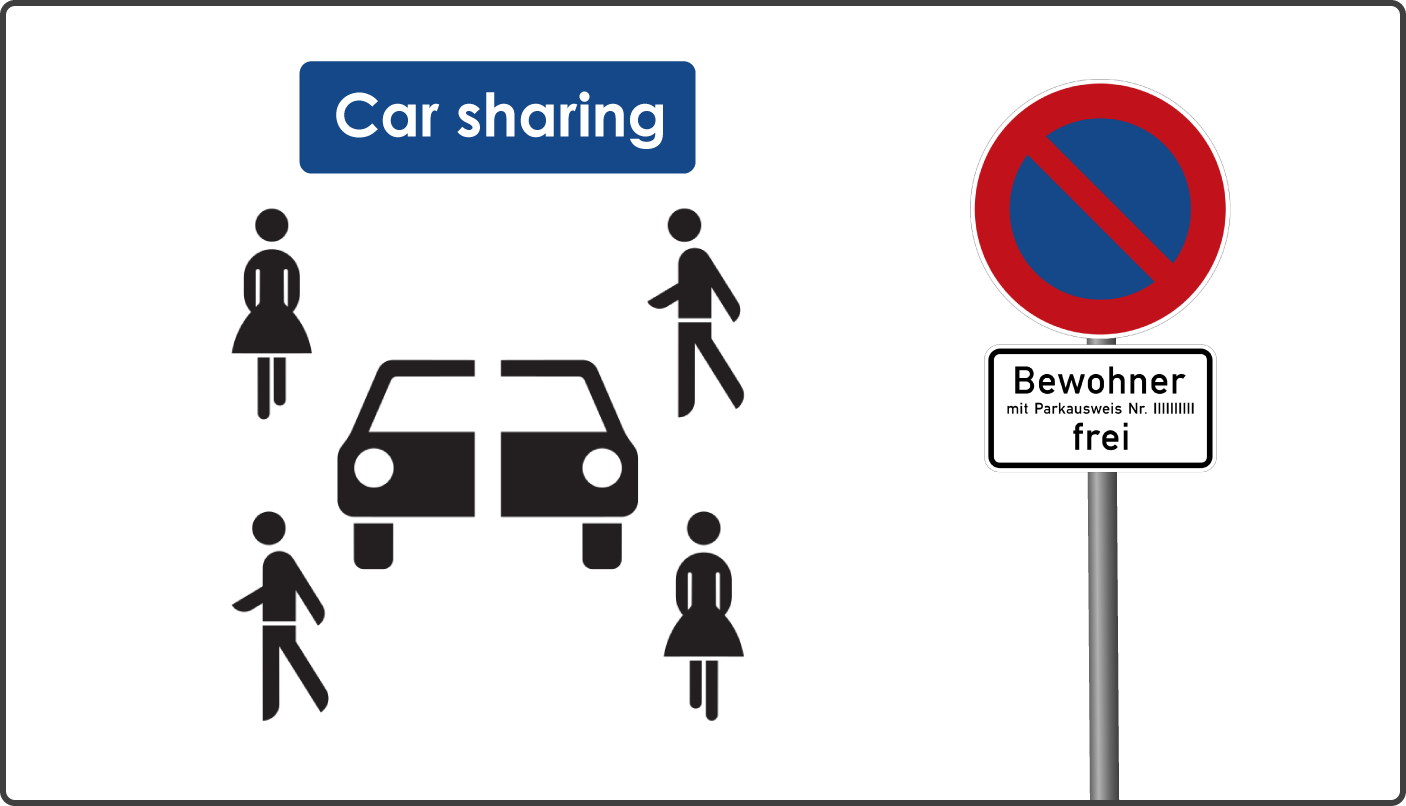
The car sharing company must be clearly recognizable from the outside of the car sharing vehicle. This can be done with an inscription or a sticker on the vehicle (VwV-StVO on section 45, paragraph 1 to 1e).
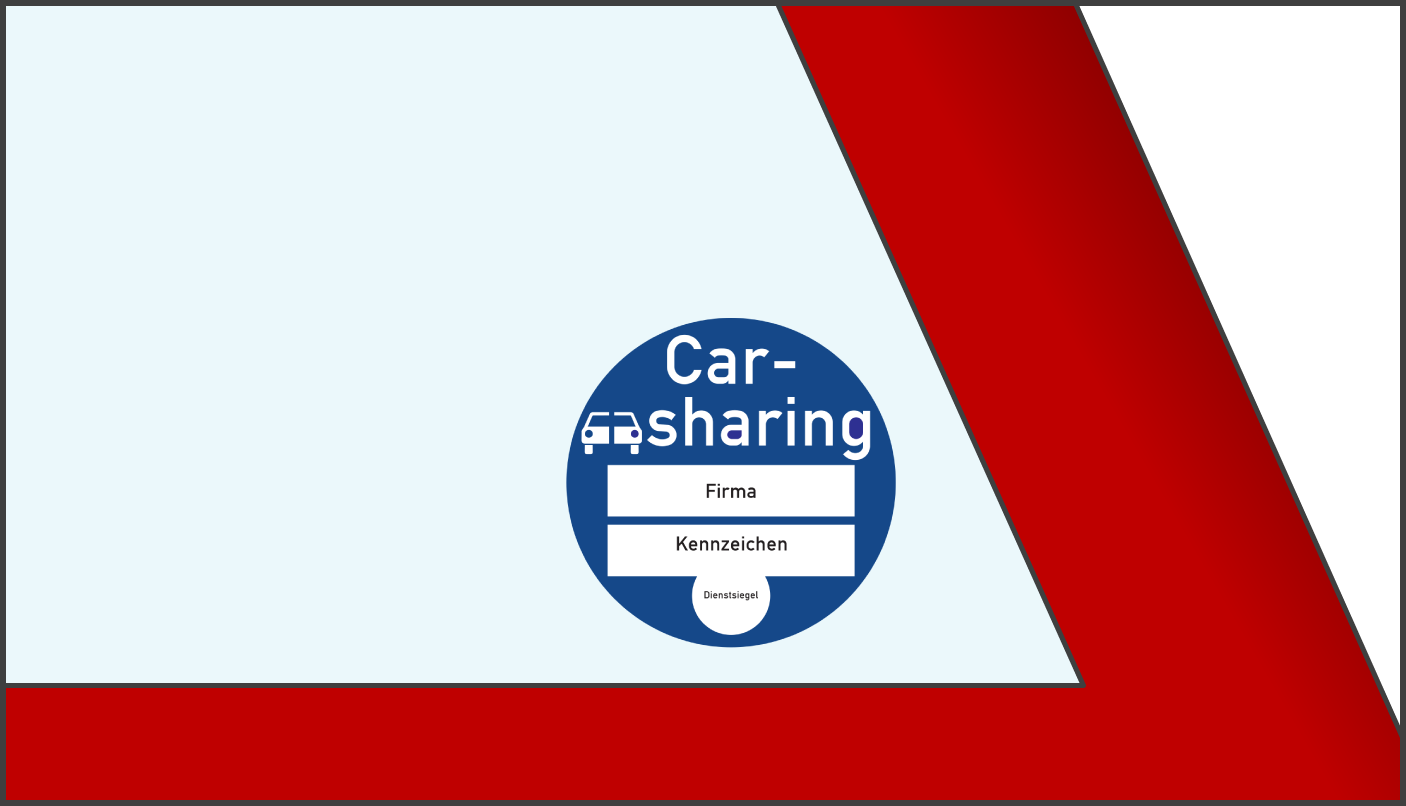
If you have a parking permit for car sharing, you may only park in resident parking spaces with car sharing vehicles from your car sharing organization (VwV-StVO on section 45, paragraph 1 to 1e).
But don’t forget to take your parking permit with you after parking in the car sharing car.
If several resident parking privileges have been granted in a city, your parking pass will still contain the number or letter of your area.
Your resident parking permit can be limited (VG Münster, judgement of 11 January 1985 – 3 K 1453/84).
This means that you may have to apply for a new resident parking permit after a certain period of time.
Parking Only For Passenger Cars
On the picture below there is an additional traffic sign with the symbol of a passenger car under a traffic sign 314 (traffic sign 1010-58).
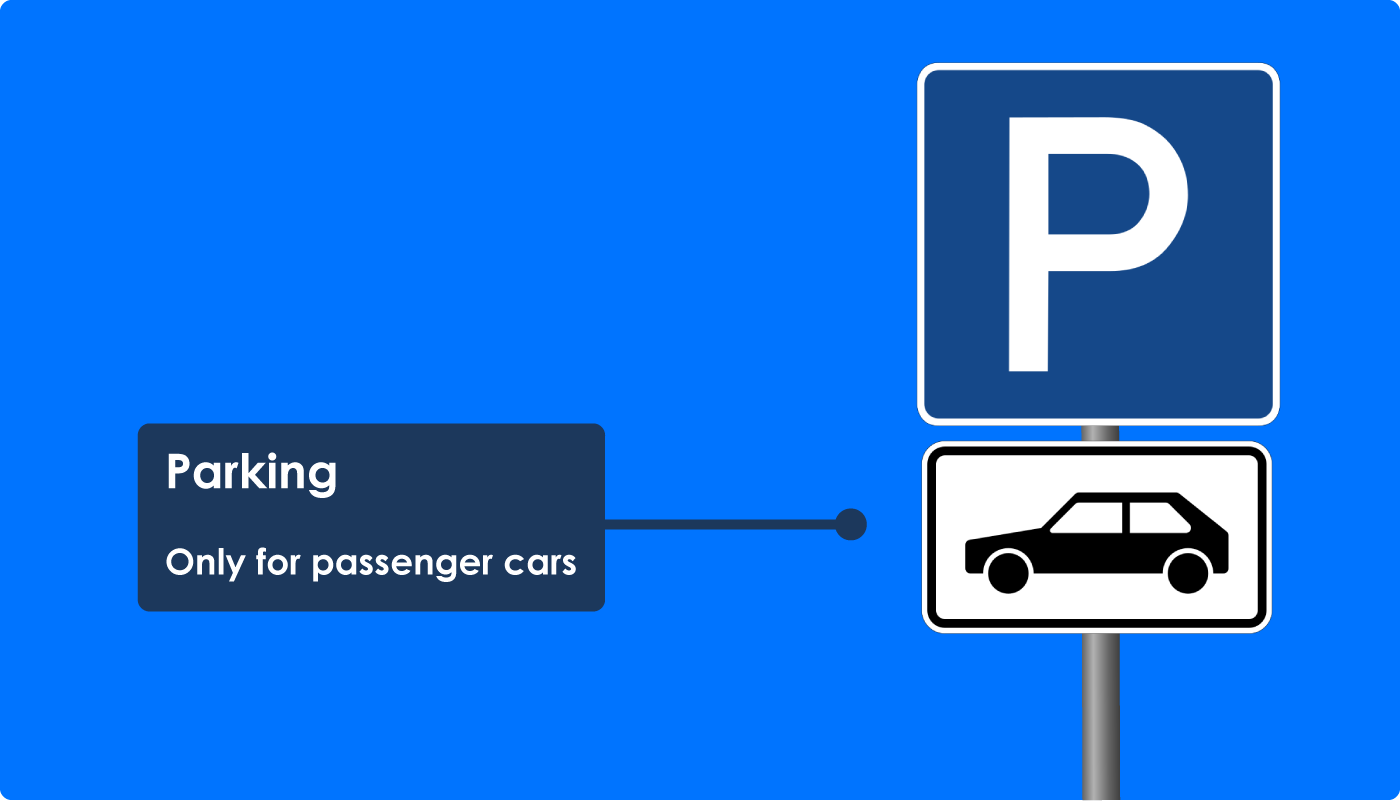
If traffic sign 314 is placed together with an additional traffic sign with the symbol of a passenger car, only passenger cars are allowed to park in the marked parking spaces.
The question arose from the community as to whether parking with mobile homes with a permissible total mass of less than 3.5 t is permitted in parking spaces with a combination of traffic sign 314 and the additional traffic sign “passenger cars”.
This is indeed a very controversial subject. You have to ask yourself the question: Are mobile homes with a permissible total mass of less than 3.5 t passenger cars, or not?
Neither the German Road Traffic Regulations (StVO) nor the German Road Traffic Licensing Regulations (StVZO) define what a passenger car actually is.
However, “Directive 2007/46/EC to establish a framework for the approval of motor vehicles and their trailers, and of systems, components and separate technical units for these vehicles” classifies mobile homes as
Vehicle(s) of category M with special purposes.[ein]
Annex II of Directive 2007/46/EC of 9 May 2007 – L 263/1
Mobile homes are coded with SA as special purpose vehicles (Annex II of Directive 2007/46/EC of 9 May 2007 – L 263/1).
Passenger cars, on the other hand, are coded with M1 (Annex II of Directive 2007/46/EC of 5 September 2007 – L 263/1).
In my opinion, mobile homes are not passenger cars.
The Higher Regional Court of Schleswig and the Court of Appeal in Berlin do not see mobile homes as passenger cars either (KG, judgement of 21 November 1991 – 2 Ss 127/91 – 3 Ws (B) 154/91; OLG Schleswig, judgement of 12 December 1990 – 1 Ss OWi 413 /90).
According to the Federal Government of Germany, mobile homes are not passenger vehicles. Mobile homes should therefore not be parked in parking spaces with a combination of traffic sign 314 and the additional traffic sign “Personenkraftwagen” (Bundestag printed paper 19/22803 of 24 September 2020 page 2).
Unfortunately, there is no supreme court judgement yet.
However, I would still advise you not to park your mobile home in parking spaces with a combination of traffic sign 314 and the additional traffic sign “Personenkraftwagen” – regardless of whether your mobile home has a maximum permissible mass of more than or less than 3.5 t.
Parking Only For Trucks
Below, you see the combination of traffic sign 314 with the additional traffic sign with the symbol of a truck (traffic sign 1010-51).
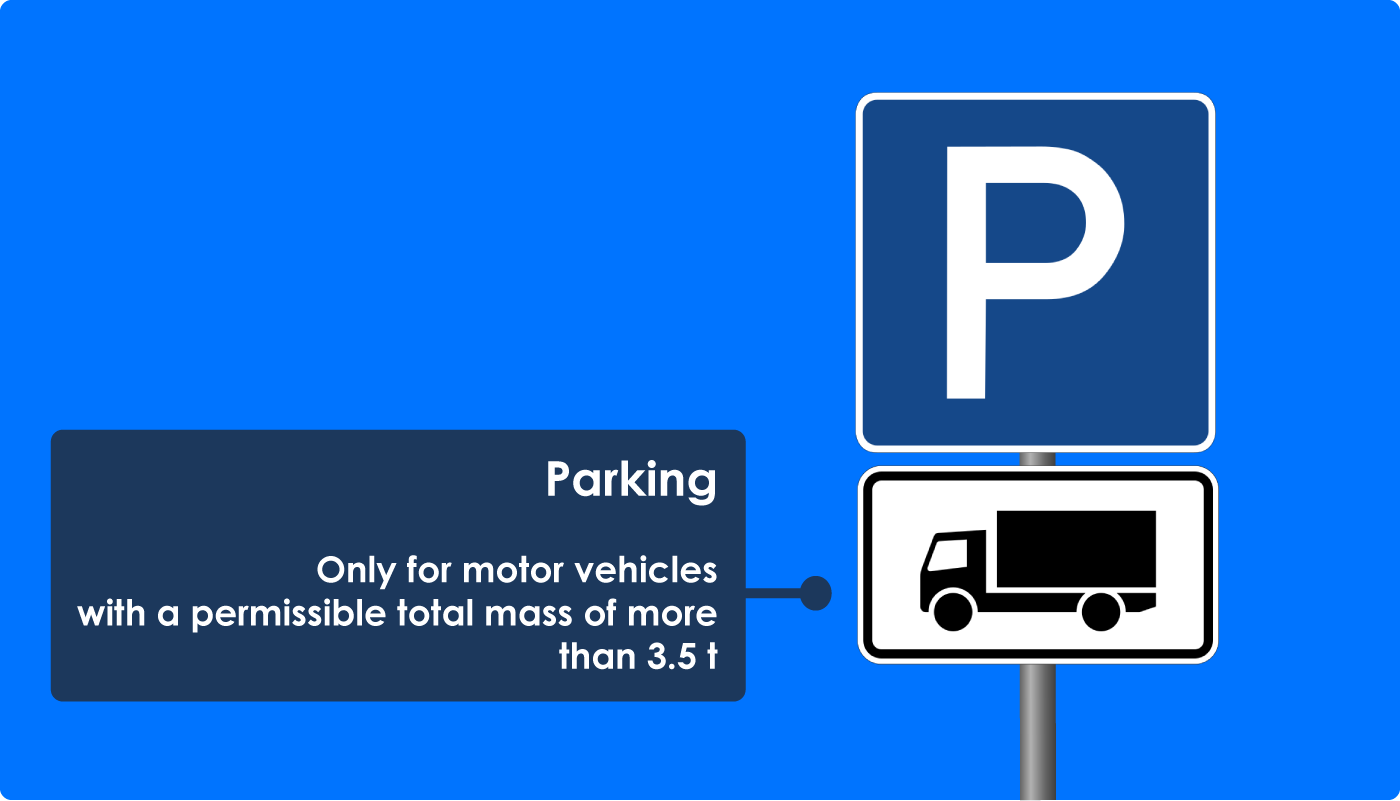
The symbol on traffic sign 1010-51 stands for motor vehicles with a permissible total mass of more than 3.5 t, including their trailers, and tractors, except for passenger cars and buses (section 39, paragraph 7 StVO).
If the traffic sign “Parken” is combined with the additional traffic sign 1010-51, parking is only permitted for the following vehicles and vehicle combinations in the marked parking spaces:
- Motor vehicles with a permissible total mass of more than 3.5 t
- Motor vehicles including their trailers with a permissible total mass of more than 3.5 t
- Tractors with a permissible total mass of more than 3.5 t
- Tractors including their trailers with a maximum permissible mass of more than 3.5 t
Passenger cars and buses are excluded from this regulation (section 39, paragraph 7 StVO).
This means that passenger cars and buses with a permissible total mass of less than 3.5 t are not allowed to park in parking spaces with a combination of traffic sign 314 and the additional traffic sign 1010-51.
Buses with a permissible total mass of more than 3.5 t are also not allowed to park in parking spaces with a combination of traffic sign 314 and the additional traffic sign 1010-51.
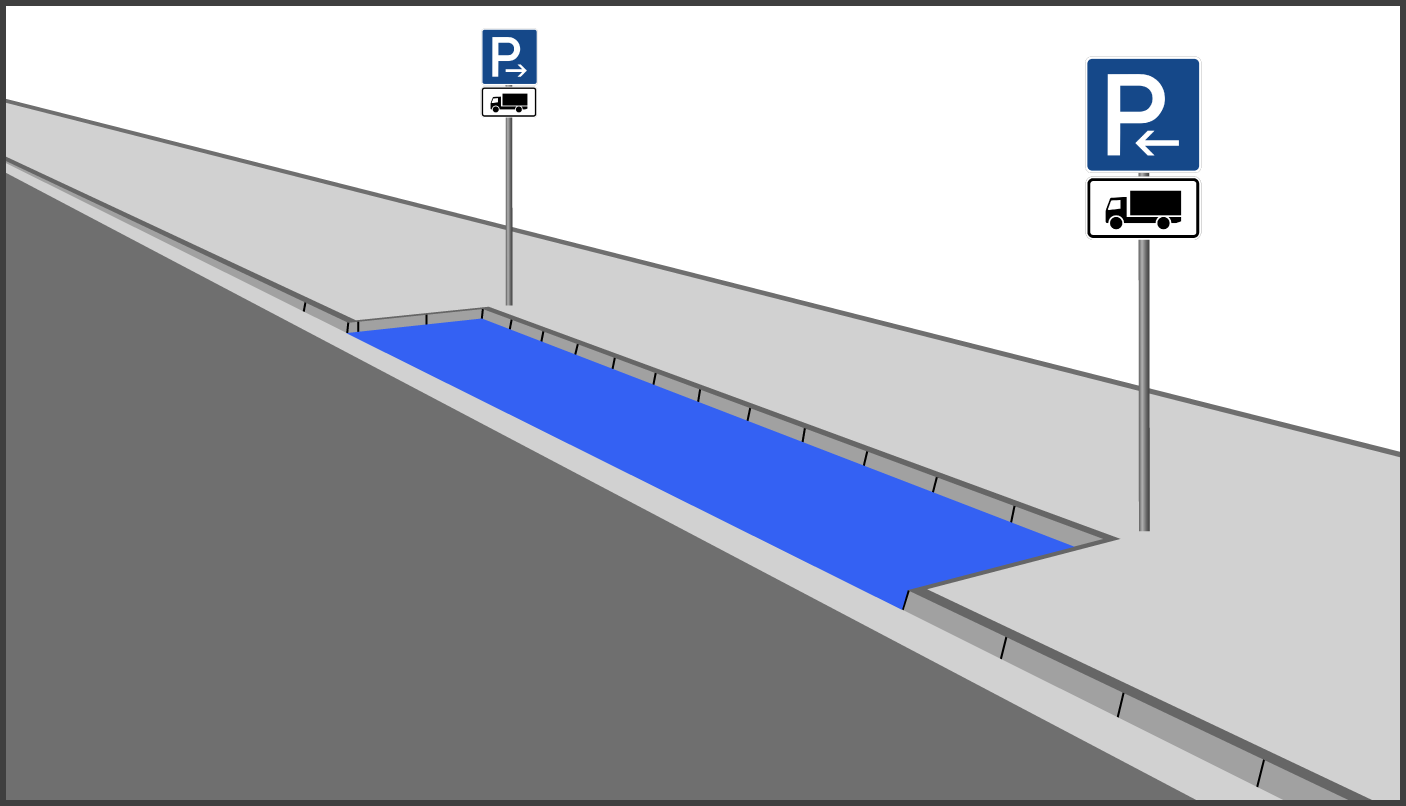
Parking with motor vehicles with a permissible total mass of less than 3.5 t is not permitted on parking spaces with traffic sign 314 and the additional traffic sign 1010-51.
In other words, trucks with a maximum permissible mass of less than 3.5 t are prohibited from parking in parking spaces with traffic sign 314 and the additional traffic sign 1010-51.
Are mobile homes with a maximum permissible mass of more than 3.5 t allowed to park in parking spaces with the combination of traffic sign 314 and the additional traffic sign 1010-51? What about mobile homes with a permissible total mass of less than 3.5 t?
Mobile homes with a permissible total mass of more than 3.5 t may park in parking spaces marked with traffic sign 314 and the additional traffic sign 1010-51. This is because mobile homes are not classified as passenger cars or buses (Bundestag printed paper 19/22803 of 24 September 2020 page 2).
However, mobile homes with a permissible total mass of less than 3.5 t are prohibited from parking in parking spaces with the traffic sign “Parken” and the additional traffic sign 1010-51 (Bundestag printed paper 19/22803 of 24 September 2020 page 2).
Parking Only For Buses
Special parking spaces can also be reserved for buses.
For this purpose, an additional traffic sign with the symbol of a bus is used (traffic sign 1010-57). This additional traffic sign is placed under traffic sign 314.
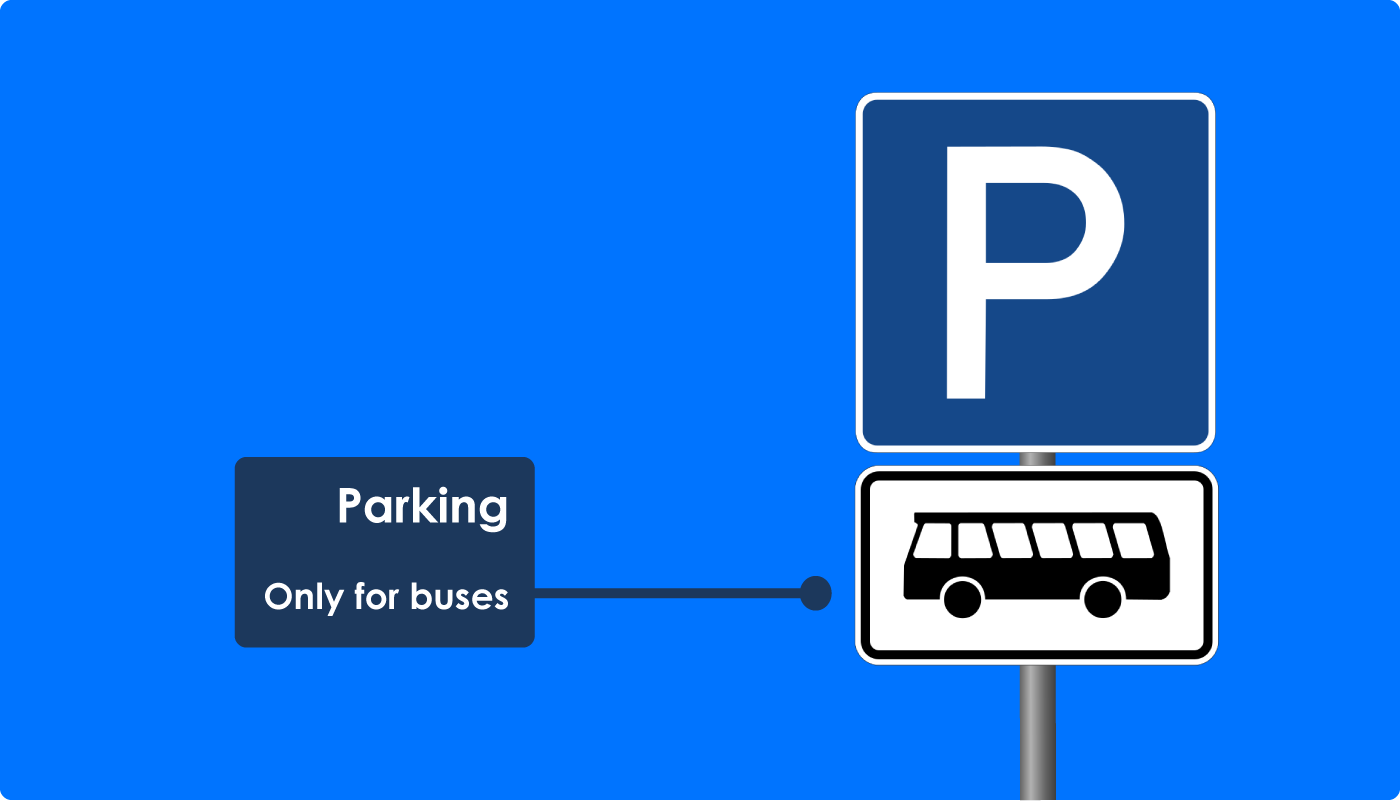
Parking Only For Mobile Homes
On the picture below there is an additional traffic sign with the symbol of a mobile home under a traffic sign 314 (traffic sign 1010-67).
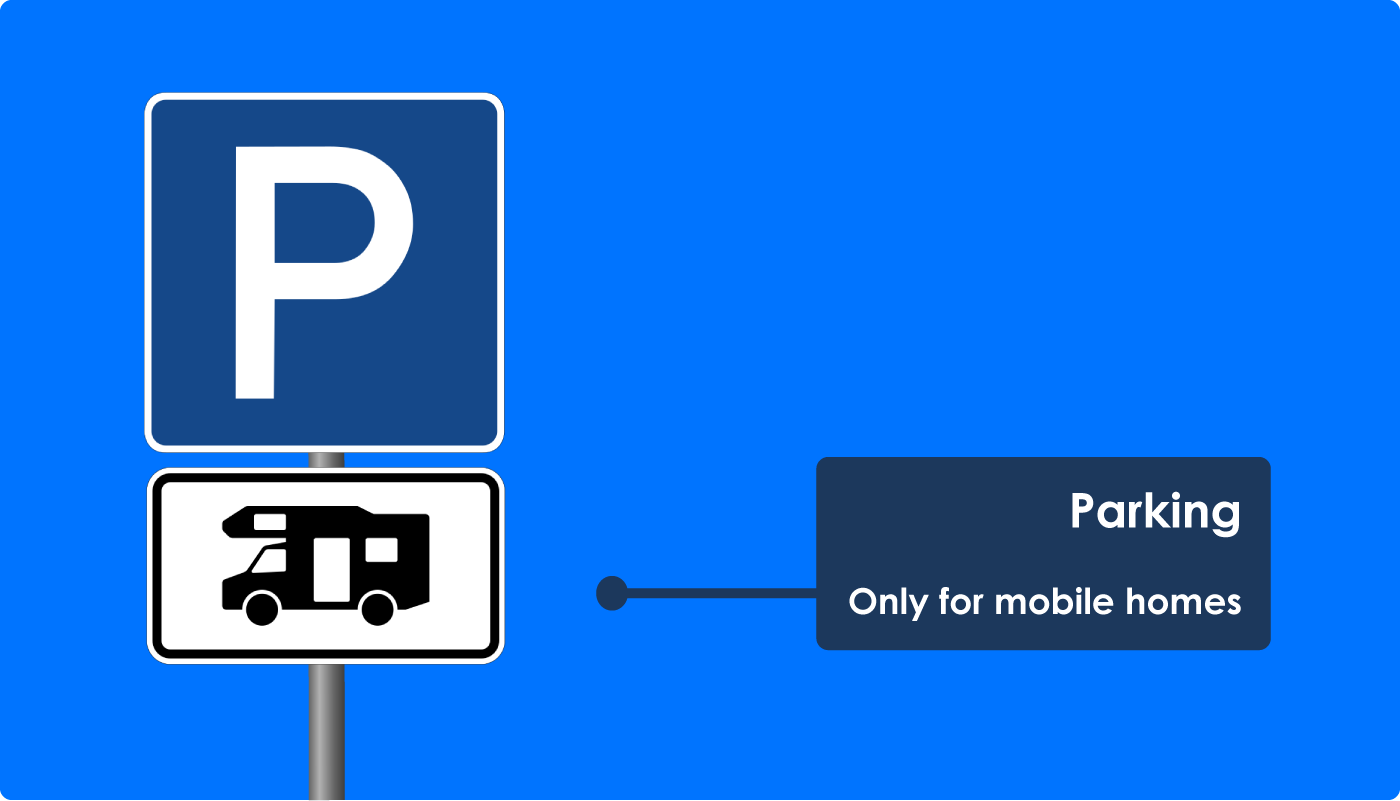
The symbol on traffic sign 1010-67 stands for mobile homes (section 39, paragraph 7 StVO).
Only mobile homes are allowed to park in parking spaces with traffic sign 314 and the additional traffic sign with the symbol of a mobile home.
Parking Only For Severely Disabled
Signage For Parking Spaces For Severely Disabled
Parking spaces with traffic sign 314 and an additional traffic sign with the symbol of a wheelchair user (traffic signs 1044-10, 1044-11) allow parking for severely disabled people with a blue parking permit.
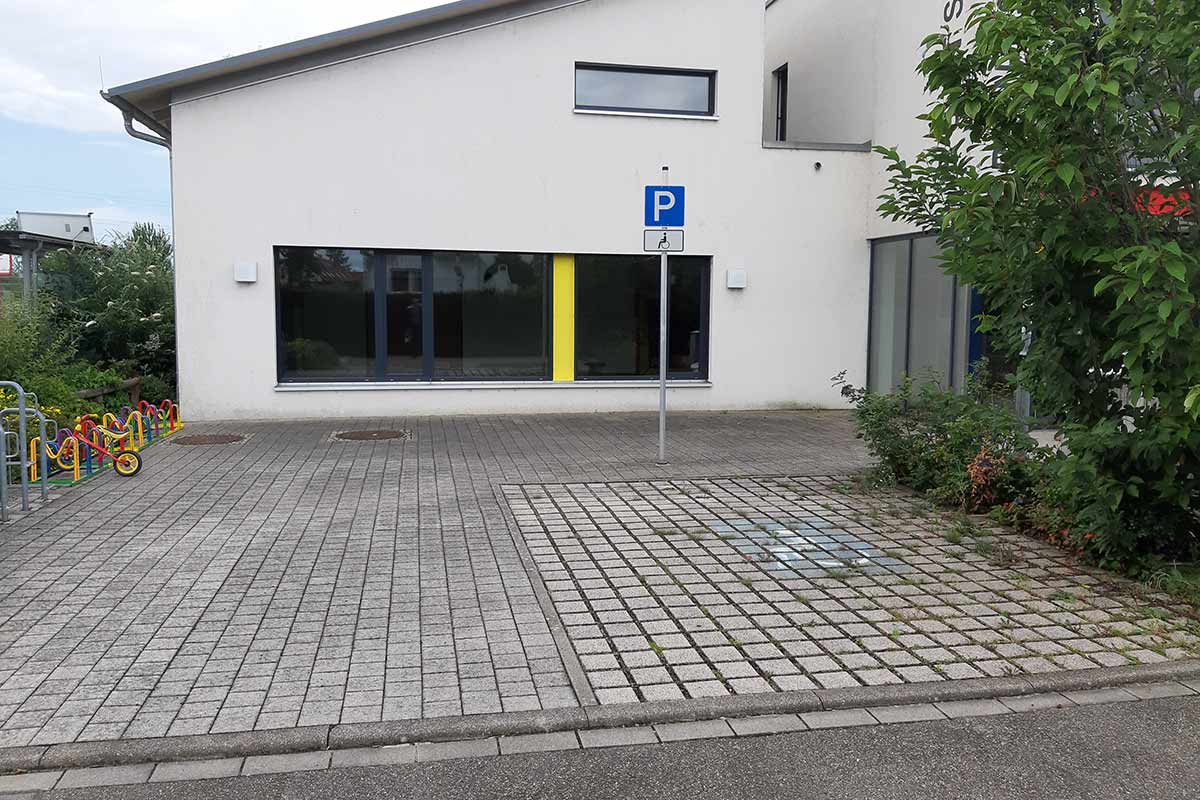
The symbol of a wheelchair user is often applied to parking spaces for the severely disabled.
The symbol of a wheelchair user is also called a marking for “disabled people” (Chapter 5.4.3 RMS part 2) or colloquially “wheelchair user symbol”.
According to the VwV-StVO, a marking “wheelchair user symbol” on the ground should also be sufficient to mark parking spaces for severely disabled people (VwV-StVO on section 45, paragraph 1 to 1e).
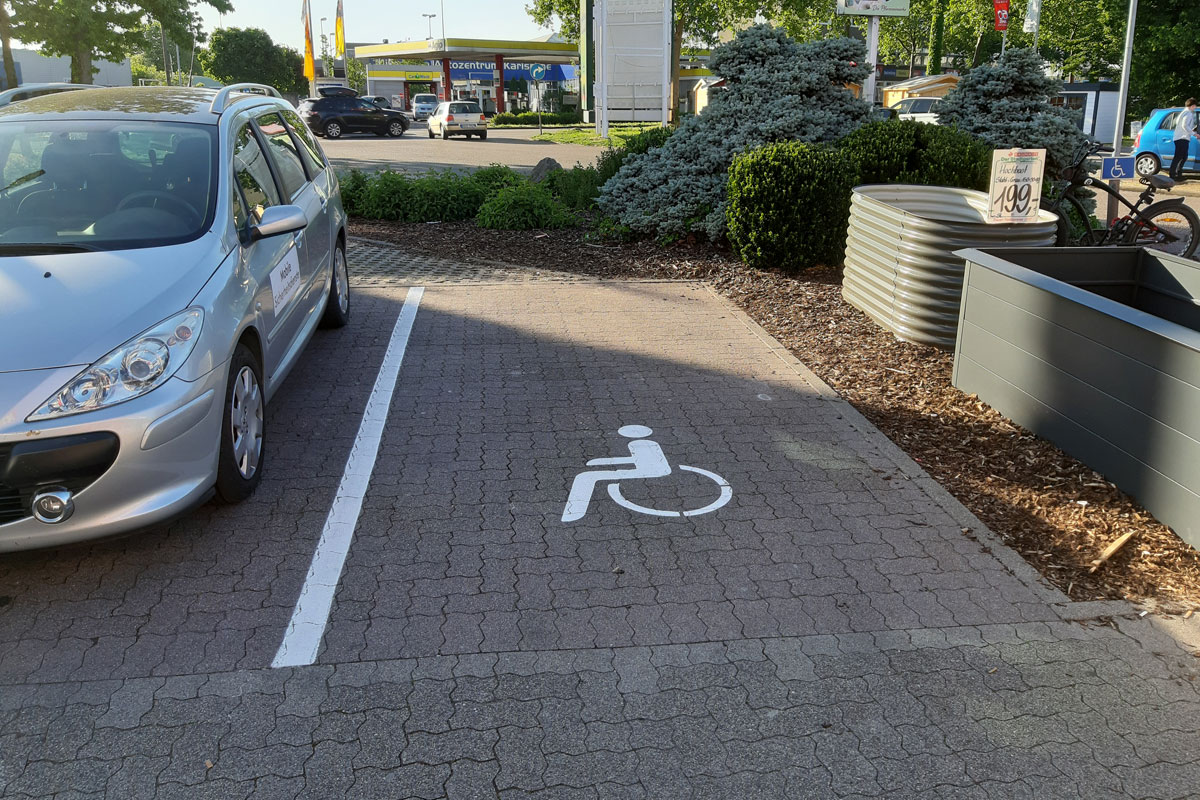
The VwV-StVO refers to the following passage:
A parking lot marking allows parking; on sidewalks, however, only vehicles with a permissible total mass of up to 2.8 t. The arrangement ordered by the parking area markings must be observed. Where it is marked with solid lines, it may be driven over.
Annex 2 consecutive number 74 StVO
However, the paragraph cited above does not say a word about the “wheelchair user symbol”.
In addition, characters and the reproduction of traffic signs on the road only serve as an indication of an attached traffic sign (section 39, paragraph 5 StVO).
I therefore think that markings on the ground are not sufficient to clearly identify a parking area reserved for the severely disabled.
The regulation results from the traffic sign 314 in combination with the additional traffic sign “wheelchair user symbol”.
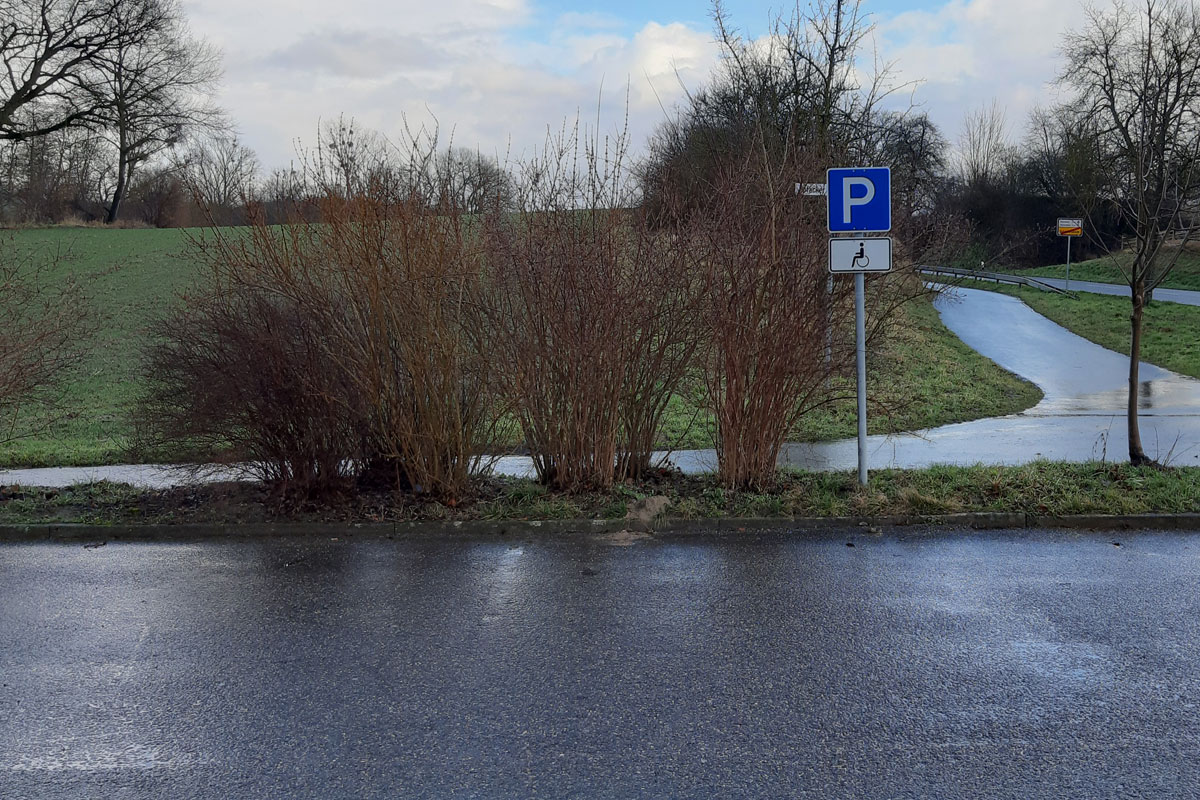
Parking spaces for severely disabled can be set up either generally for severely disabled people (traffic sign 1044-10) or for specific persons (traffic sign 1044-11).
In the case of parking spaces which are generally only for severely disabled near authorities, hospitals and orthopedic clinics, you must also expect an additional time limit for parking spaces only for severely disabled (VwV-StVO on section 45, paragraph 1 to 1e).
If parking areas are restricted with traffic sign 314 and an additional traffic sign “Nur Schwerbehinderte mit Parkausweis Nr. …” (traffic sign 1044-11), only the person who is in possession of this special parking permit may park in the parking lot.
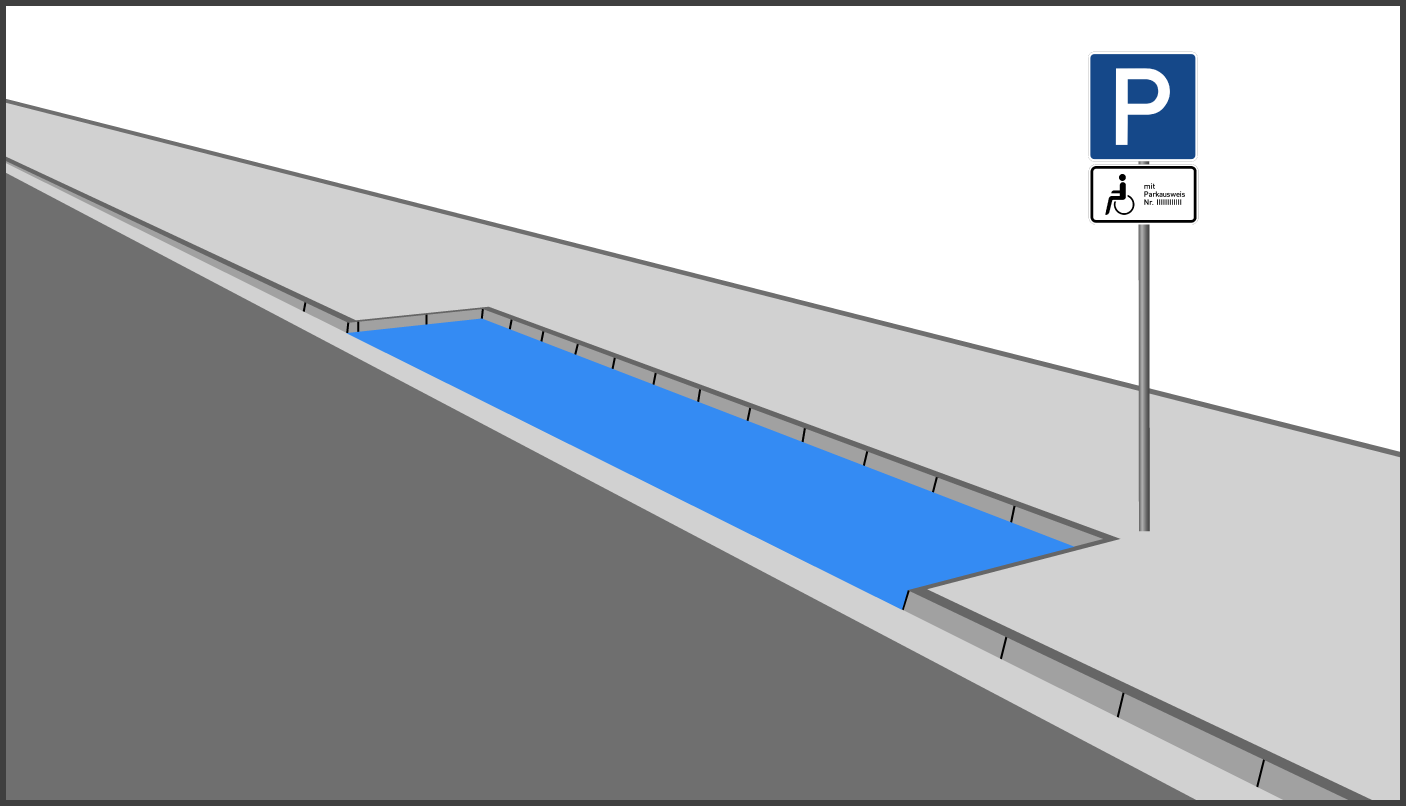
However, severely disabled parking spaces for a specific person are very rare.
This is because the hurdles are relatively high (VwV-StVO on section 45, paragraph 1 to 1e).
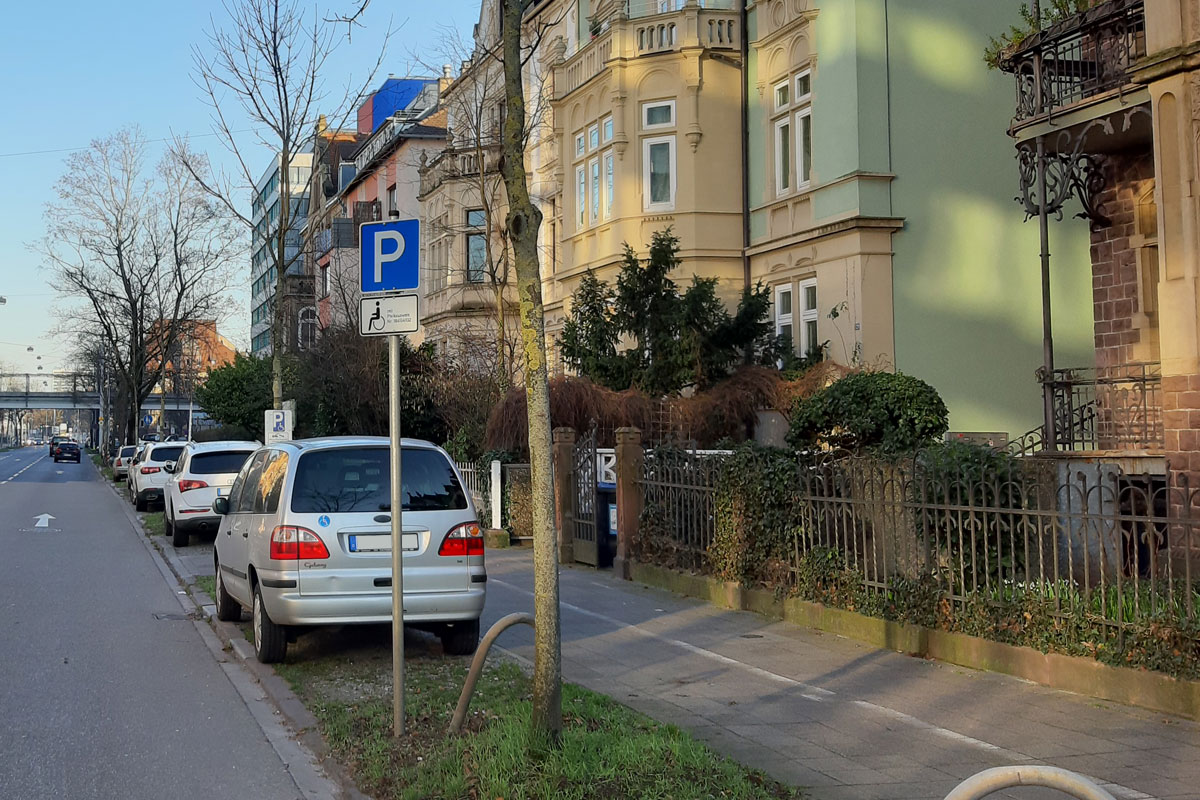
Parking Spaces for a specific severely disabled person may not be set up, for example, if
- There is no lack of parking space for severely disabled, or the severely disabled person has a garage or a parking space outside public traffic area within a reasonable distance,
- a “No stopping” traffic sign (traffic sign 283) has been ordered or
- a time-limited special parking right is sufficient.
Blue And Orange Parking Permits
Blue parking permits are only given to people with
- Extraordinary walking disability (mark aG),
- Bilateral Amelie,
- Phocomelia or
- Blind people (mark Bl)
issued upon application (Annex 3 consecutive number 7 StVO).
The blue parking permit is valid throughout the European Union. This means that you can park with your blue parking permit in all member states of the European Union in parking areas with traffic sign “Parking” and an additional traffic sign “wheelchair user symbol”.
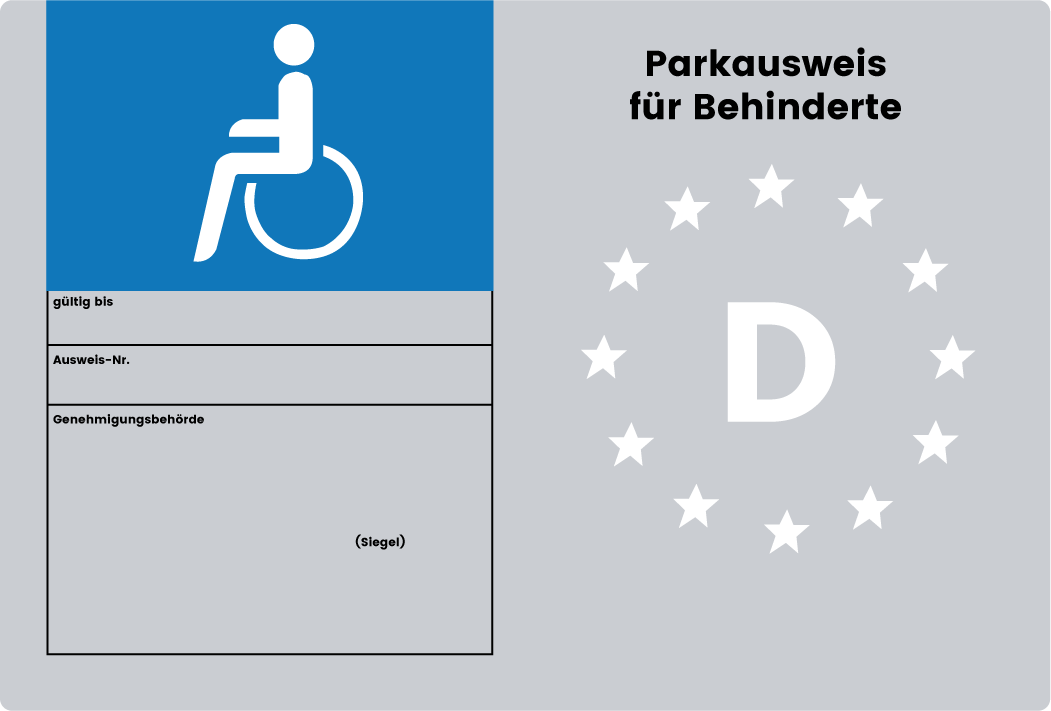
Important: If you cannot drive a car yourself, you can still apply for a blue parking permit. In the application, you simply state that you have an accompanying person.
If you are traveling with your companion, your companion can then park in disabled parking spaces.
Orange parking permits are issued to severely disabled people upon application under certain conditions (VwV-StVO on section 46, paragraph 1 number 11).
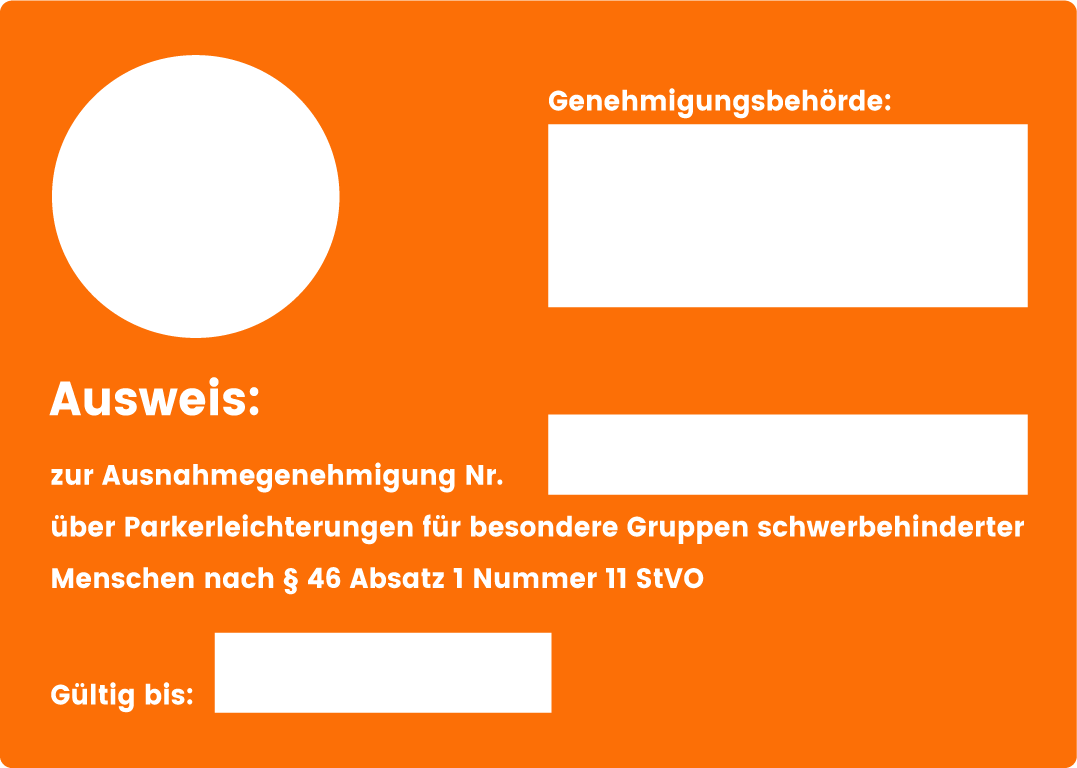
If you have an orange parking permit, you are not allowed to park in disabled parking spaces.
Parking Only For Electric Cars
Road traffic authorities can give priority to electrically powered vehicles (section 45, paragraph 1g StVO).
However, electrically powered vehicles only means vehicles in accordance with the German Electromobility Act (EmoG).
In short: This applies to vehicles with number plates with an E (section 39, paragraph 10 StVO, section 9a, paragraph 2, 4 and 5 FZV).
For example, electrically powered vehicles can be given priority when parking (section 3, paragraph 4 EmoG).
For this purpose, traffic sign 314 is combined with an additional traffic sign with the symbol for “electric powered vehicles” (traffic sign 1010-66).
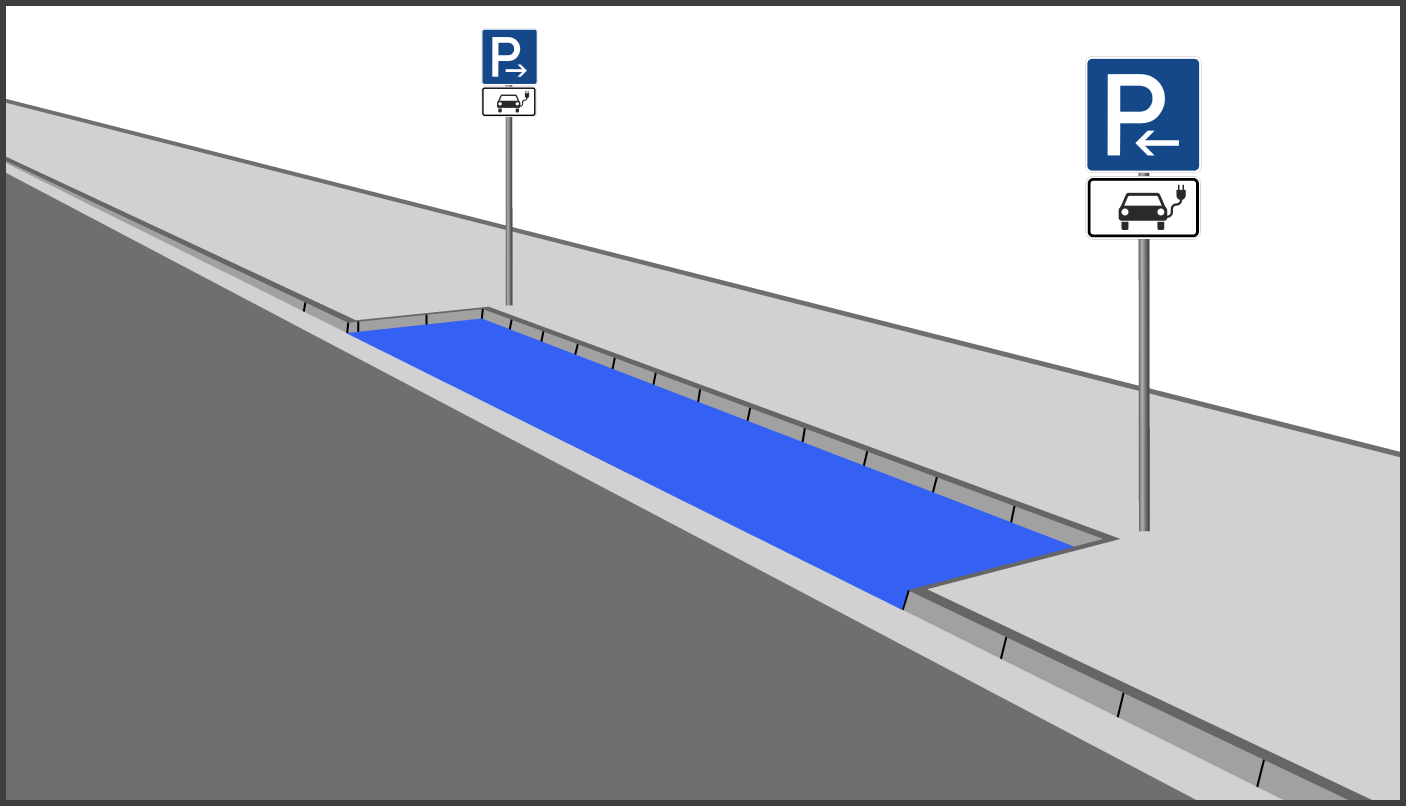
The symbol looks like a car with a plug.
Symbols of electrically powered vehicles, which are placed on the roadway, are only additional information (section 39, paragraph 10 StVO).
The traffic regulation is based on the combination of the traffic sign 314 with the additional traffic sign with the symbol of an electrically powered vehicle.
But what about electric vehicles that do not have a number plate with an E?
Can electric vehicles without a number plate with an E be parked in parking spaces with traffic sign 314 and an additional traffic sign with the symbol of an electrically powered vehicle?
The answer will surprise you:
Electric vehicles without a number plate with an E may not be parked in parking spaces with traffic sign 314 and an additional traffic sign with the symbol of an electrically powered vehicle.
If you do, you are committing an offence.
If parking spaces were to be reserved for all electric powered vehicles, traffic sign 314 would have to be erected with an additional traffic sign reading “Elektrofahrzeuge”.
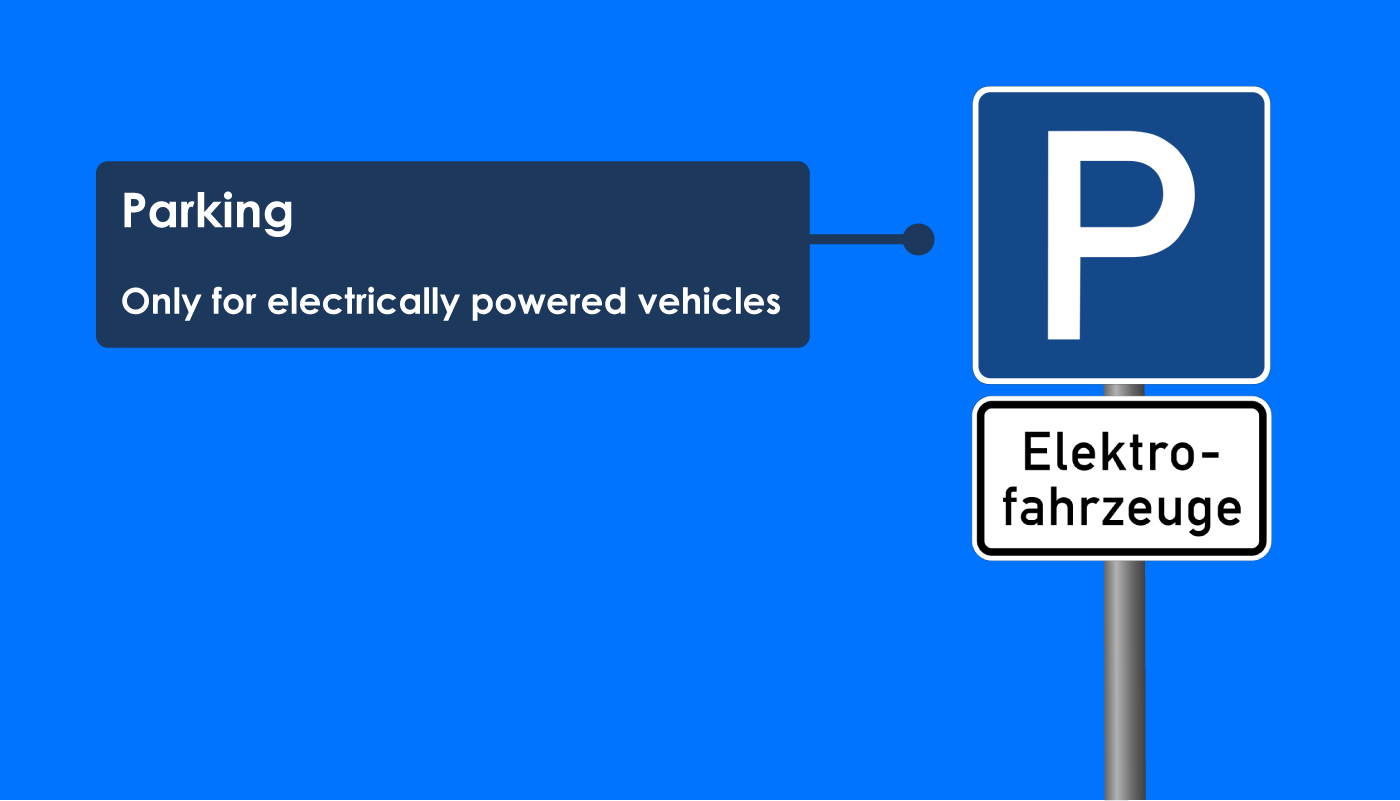
The additional traffic sign “Elektrofahrzeuge” (traffic sign 1050-33) is part of the traffic sign catalogue. It is an official traffic sign.
However, there is no legal basis in the German Road Traffic Regulations (StVO) for the arrangement of the additional traffic sign “Elektrofahrzeuge”.
The Labour Court of Lüdinghausen, for example, argues that there is no legal basis for the arrangement of an additional traffic sign with the inscription “Elektrofahrzeuge” (AG Lüdinghausen, judgement of 15 June 2015 – 19 OWi-89 Js 1159/15-88/15).
The road traffic authorities are therefore not authorized to set up traffic sign 314 with an additional traffic sign which says “Elektrofahrzeuge”.
This means that there is currently no way to reserve parking spaces for electrically powered vehicles without a number plate with an E.
Parking Only For Electric Cars During Charging
If you want to charge your electrically powered car, you can look for parking spaces that are signposted with traffic sign 314 and an additional traffic sign which says “Elektrofahrzeuge während des Ladevorgangs” (traffic sign 1050-32).
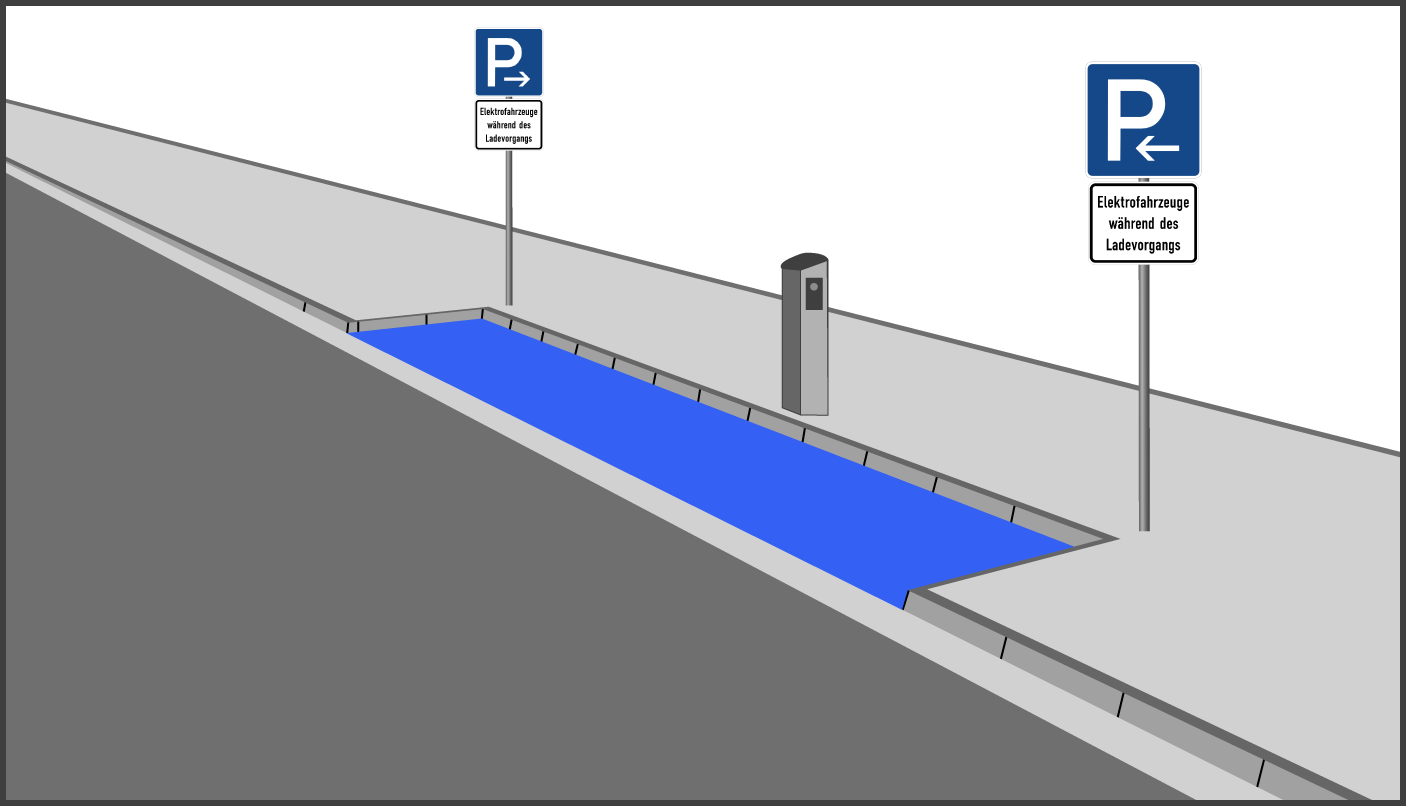
The additional traffic sign “Elektrofahrzeuge während des Ladevorgangs” has been part of the traffic sign catalogue since 2011 (VkBl 2011 page 199).
However, there is – even with the introduction of the EmoG – no legal basis for ordering the additional traffic sign “Elektrofahrzeuge während des Ladevorgangs”.
If the Road Traffic Authority puts up traffic sign 314 and an additional traffic sign that says “Elektrofahrzeuge während des Ladevorgangs” the signage is unlawful.
Does that mean that signage with traffic sign 314 and an additional traffic sign saying “Elektrofahrzeuge während des Ladevorgangs” is invalid – that is to say does not have to be observed?
Even before the introduction of the EmoG, at least the Higher Regional Court of Cologne and the Higher Regional Court of Hamm were in favour of the fact that the regulation of traffic sign 314 with the additional sign “Elektrofahrzeuge während des Ladevorgangs” was clear (OLG Hamm, judgement of 27 May 2014 – 5 RBs 13/14; OLG Köln, judgement of 12 December 2013 – 1 RBs 349/13).
The administrative act is effective even without a power norm.
I would therefore advise you to follow the traffic signs accordingly and only use the parking areas with your electric vehicle while it is charging.
On the other hand, parking spaces with charging stations can also be signposted with the traffic sign 314 and the additional traffic sign with the symbol for “Elektrofahrzeuge”.
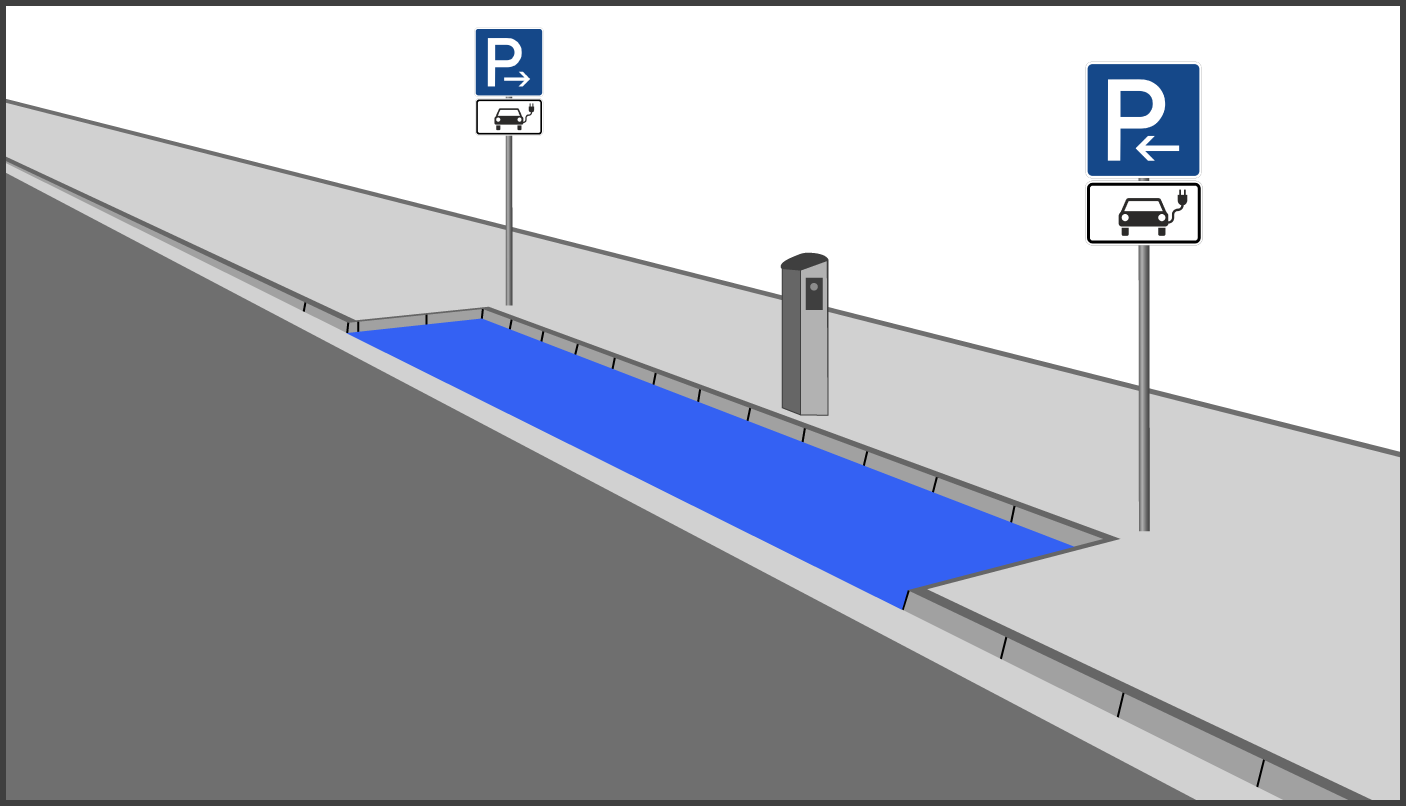
However, the additional traffic sign with the symbol for electrically powered vehicles does not describe the charging process, but generally reserves parking spaces for electrically powered vehicles according to EmoG.
This means that electrically powered vehicles without a number plate with an E may not be parked here. You are also not allowed to charge your electrically powered vehicles without a number plate with an E here.
Crazy, right?
Well …
at least you can continue to park in these parking spaces after the end of the charging process if your car has a number plate with an E.
Parking Only For Bicycles
To reserve parking spaces for bicycles, an additional traffic sign with the symbol of a bicycle must be installed under traffic sign 314 (traffic sign 1010-52).
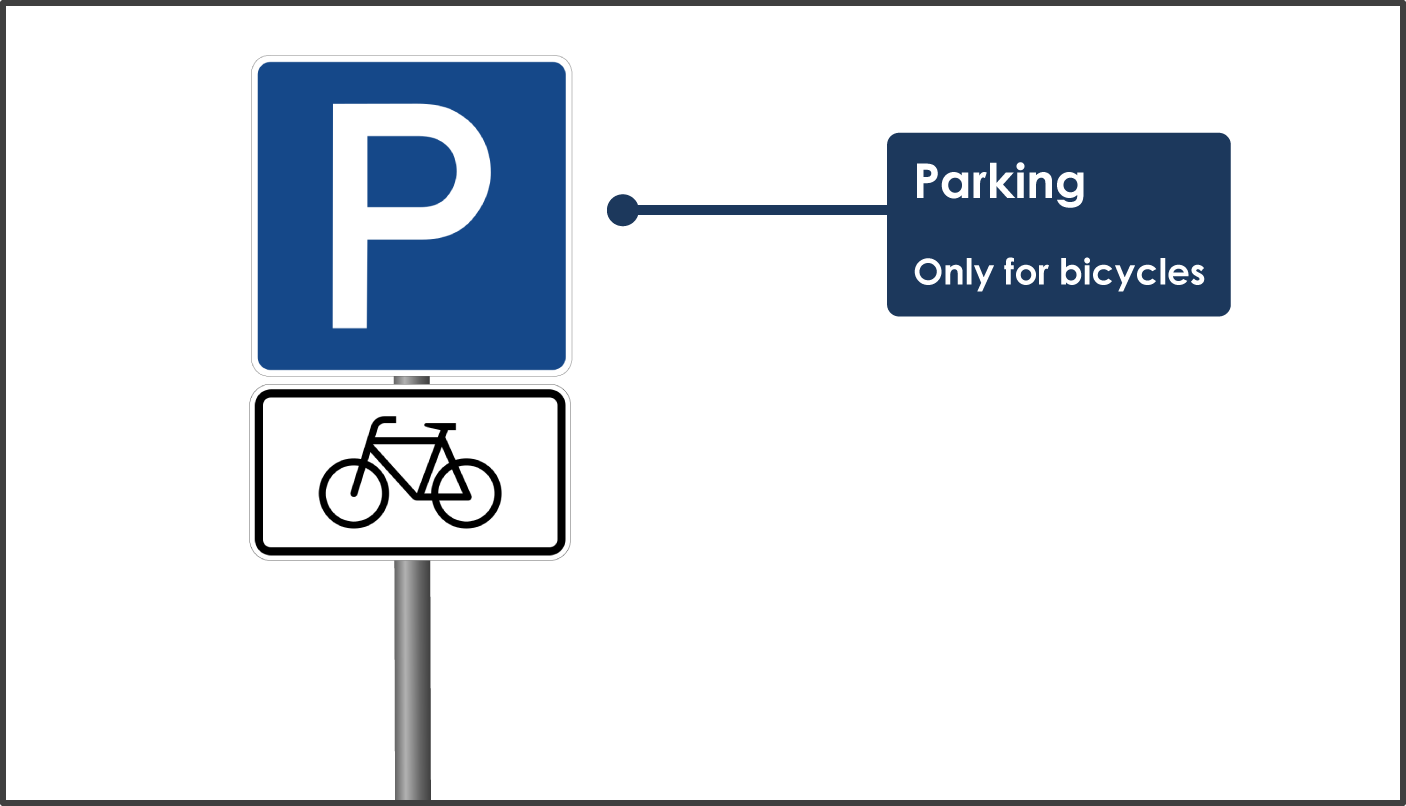
Cars, motorcycles, and other vehicles may not be parked on such parking spaces (VwV-StVO on traffic sign 314).
Parking Only For Cargo Bikes
Since the introduction of the new German Road Traffic Regulations in 2020 (StVO 2020), the combination of traffic sign 314 with an additional traffic sign with the symbol “Lastenfahrrad” is possible.
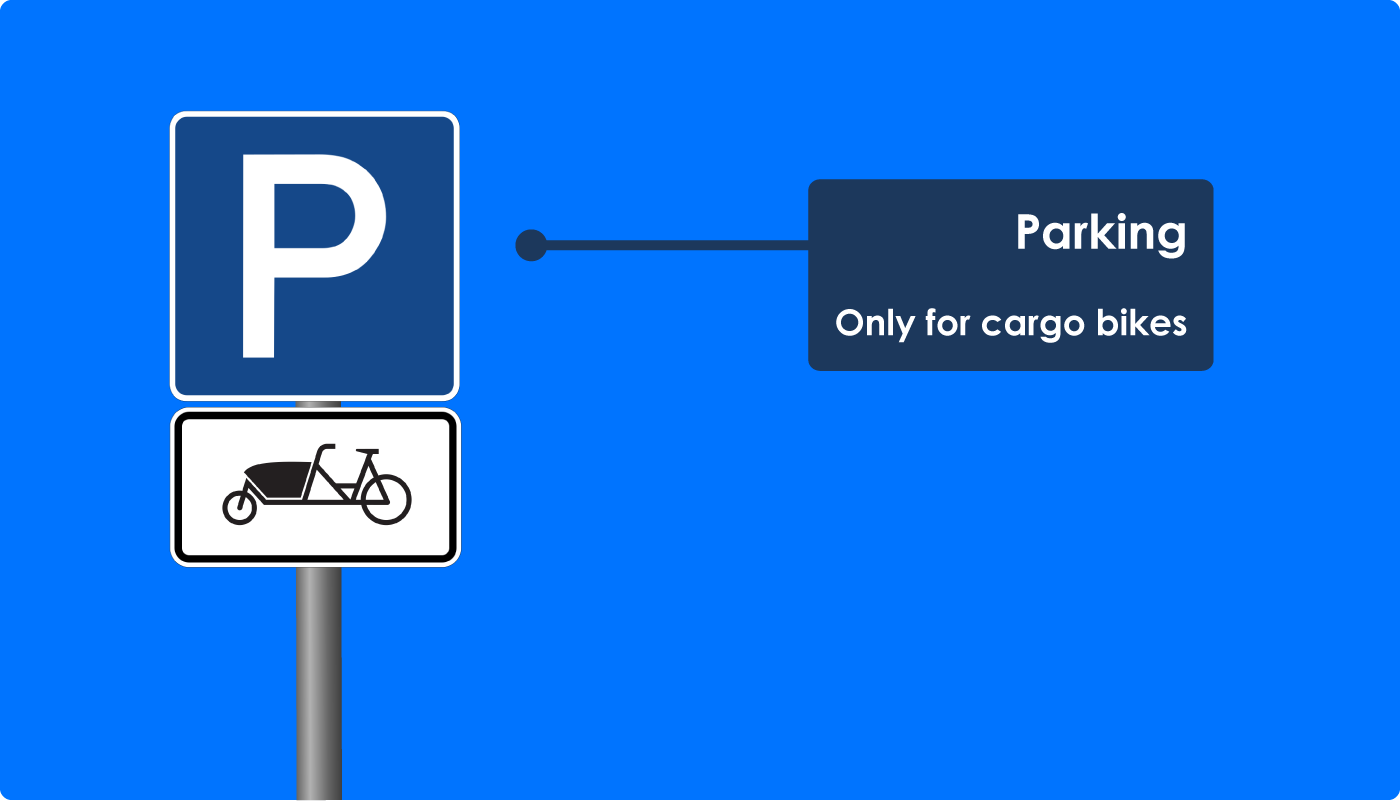
Only cargo bikes may be parked here.
Traffic sign 314 with an additional traffic sign with the symbol “Lastenfahrrad” can apply to the roadway or hard shoulder.
You can read about other traffic signs that were newly included in the StVO in 2020 in my article 6 new traffic signs for cyclists in 2020.
Parking Only For Car Sharing
Also, new with the StVO amendment 2020 was the symbol “Carsharing”.
The symbol for “Carsharing” can be applied to an additional traffic sign (section 39, paragraph 11 StVO).
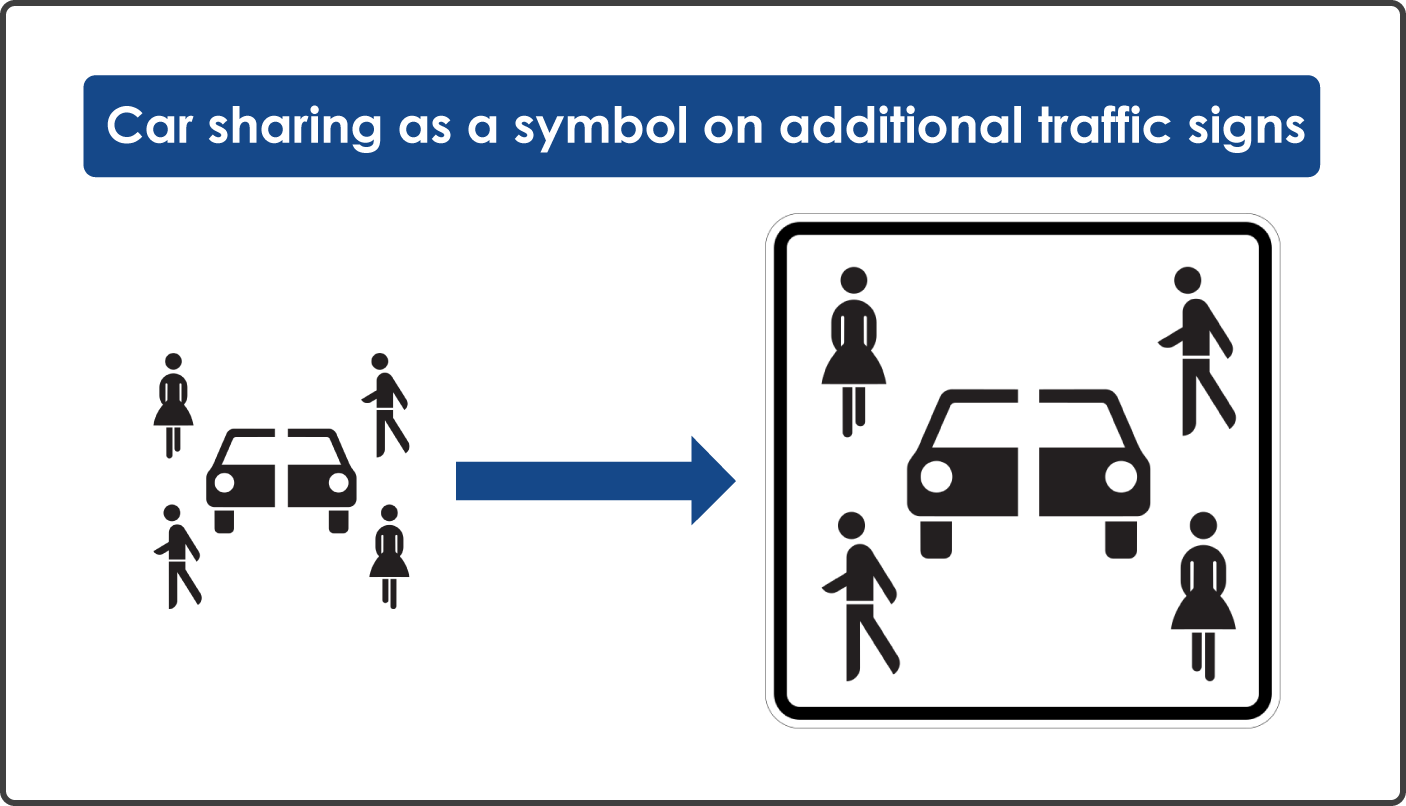
The additional traffic sign “Carsharing” is used to prioritize “Carsharing” vehicles.
“Preferential treatment” is basically a paraphrase for the promotion of “Carsharing”.
If traffic sign 314 is combined with the additional traffic sign “Carsharing”, parking in the marked areas is only possible with “Carsharing” vehicles.
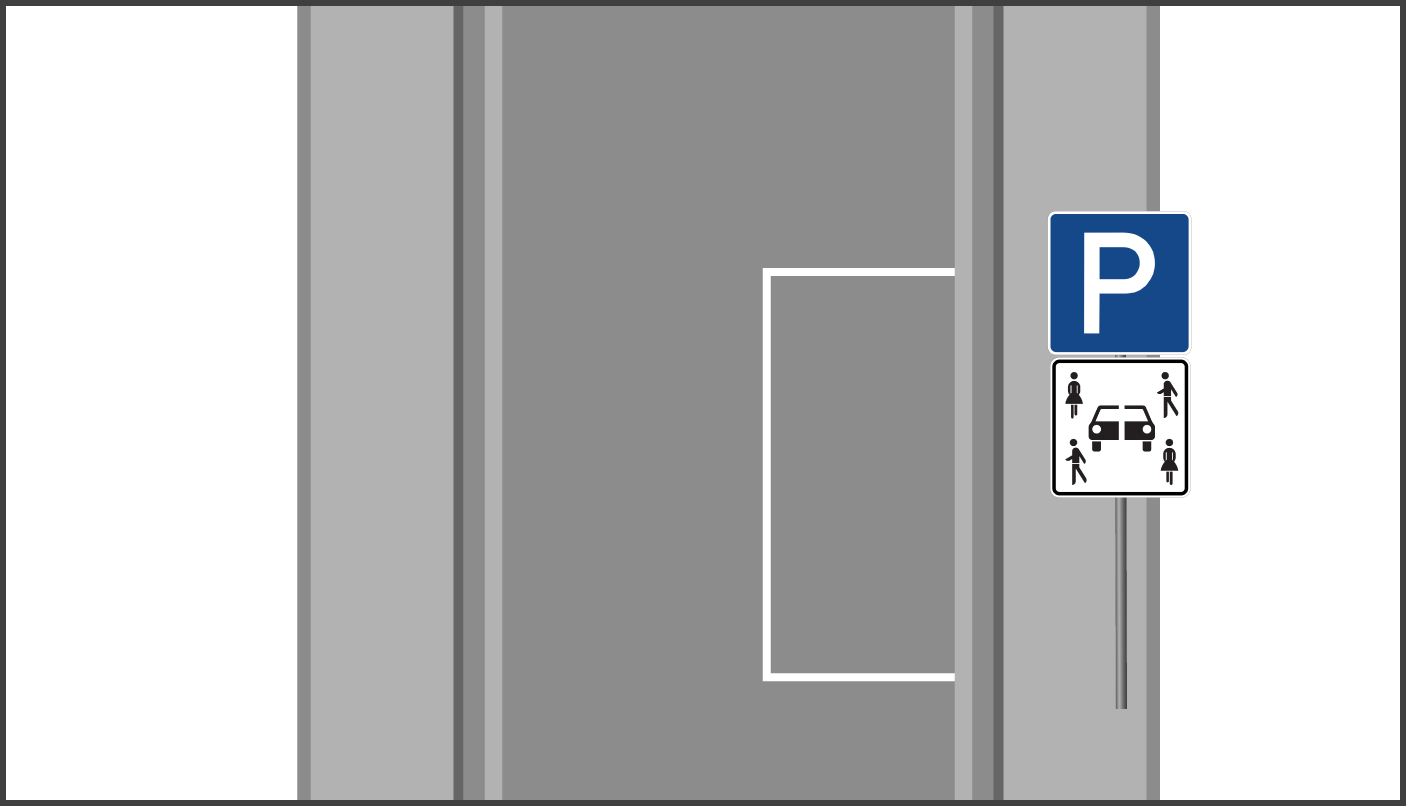
Below, you can see how vertical parking spaces are reserved for “Carsharing” vehicles.
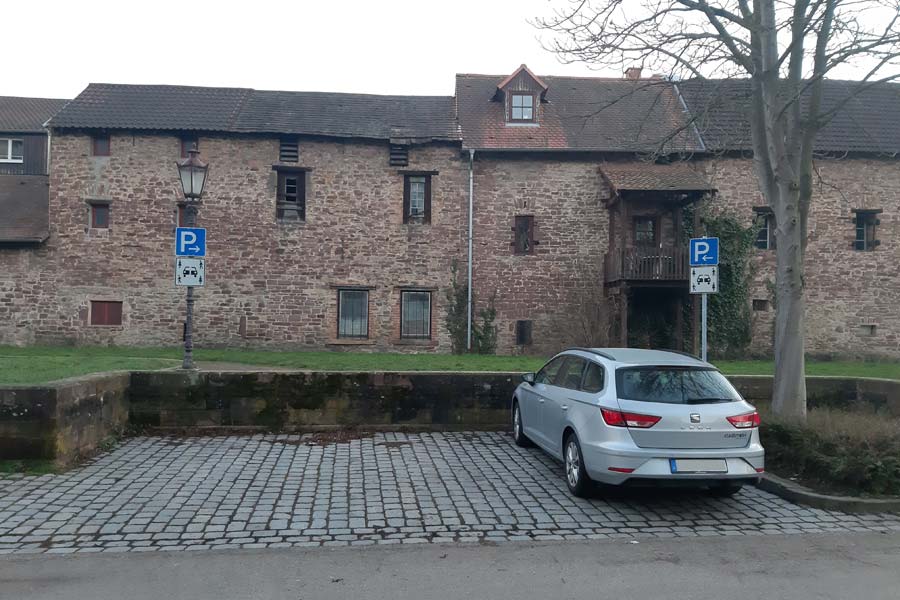
For example, a “Carsharing” vehicle from the Stadtmobil CarSharing group is parked in the parking lot on the right on the picture above.
The signage for “Carsharing” parking spaces is arranged by the road traffic authority (section 45, paragraph 1h StVO).
Traffic sign 314 with several additional traffic signs
What actually applies if several additional traffic signs are mounted under a traffic sign 314?
In order to clarify this question, we have to start from the beginning:
Traffic sign 314 is a so-called information sign. First of all, there are no rules of conduct based on information signs. If traffic sign 314 stands alone, it points to parking spaces.
If traffic sign 314 is placed in conjunction with an additional restrictive traffic sign, the combination restricts use of the parking area.
Traffic sign 314 becomes a sign giving order with an additional restrictive traffic sign (Hentschel/König/Dauer, Straßenverkehrsrecht, 44th edition 2017, marginal number 57 on section 12 StVO).
However, if there are several additional traffic signs under traffic sign 314, it gets tricky.
Why is that?
German traffic law allows for different interpretations if there are several additional traffic signs under a main traffic sign.
- Interpretation: All additional signs relate to the traffic sign above them.
- Interpretation: Individual additional traffic signs form logical groups.
- Interpretation: All additional traffic signs refer to the main traffic sign.
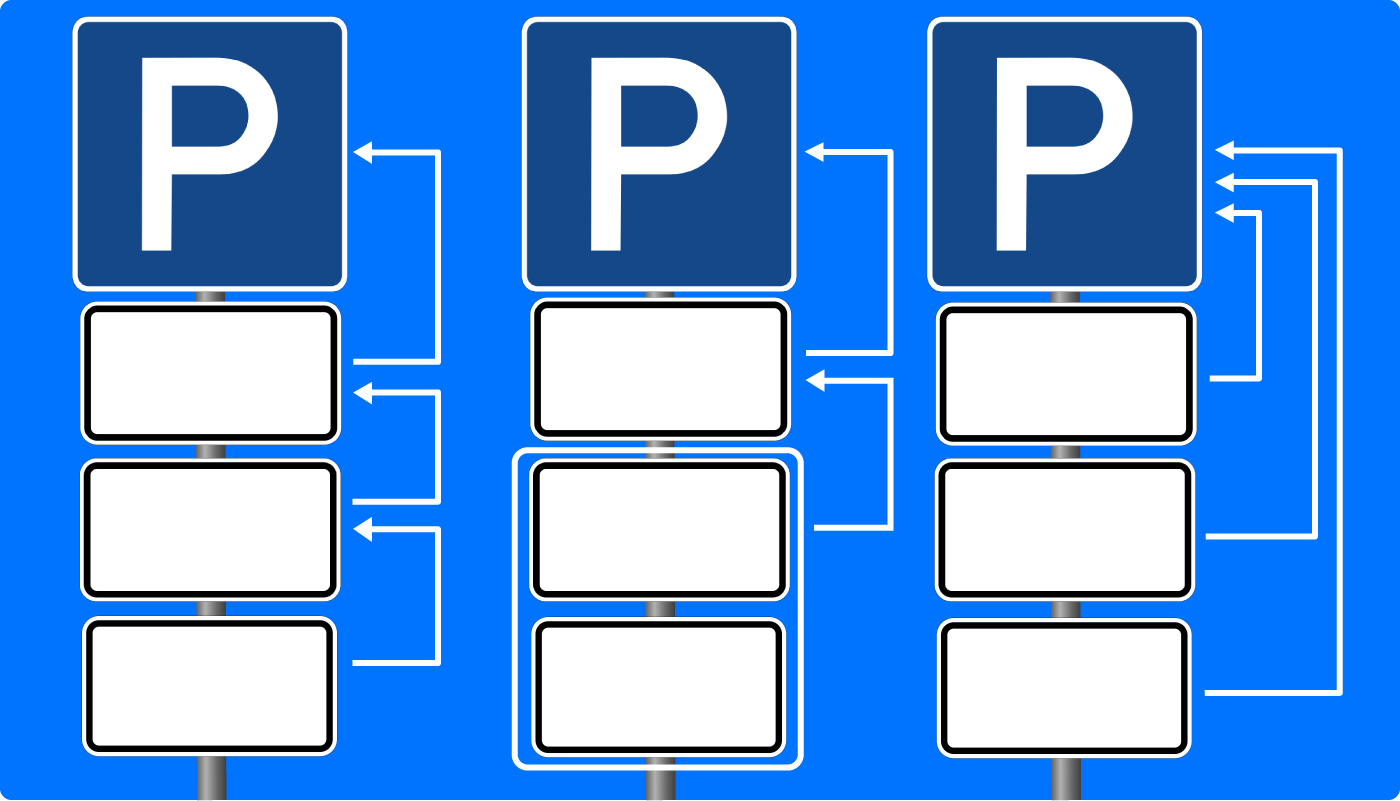
First shock digested?
I have already dealt with this issue in my article “No waiting” sign.
Therefore, I would like to spare you from further details here.
However, due to the regulations of the StVO and the VwV-StVO, there are some cases with two additional traffic signs under traffic sign 314, which nevertheless reflect a clear regulation.
These cases are exceptions to parking space management measures and restrictions on car sharing vehicles from one or more car sharing companies.
In the case of exemption from ordered parking space management measures, only a combination of the main traffic sign 314 and other additional traffic signs can be considered (VwV-StVO on section 45, paragraph 1 to 1e).
The parking space management measures include (VwV-StVO on section 13).
- Displaying a parking disc
- Operating a parking meter
- Operating a parking ticket machine
Parking Only With Parking Disc, But Passenger Cars Free
An example: Certain groups of people can be exempted from the limitation of parking time with a parking disc by means of an additional traffic sign.
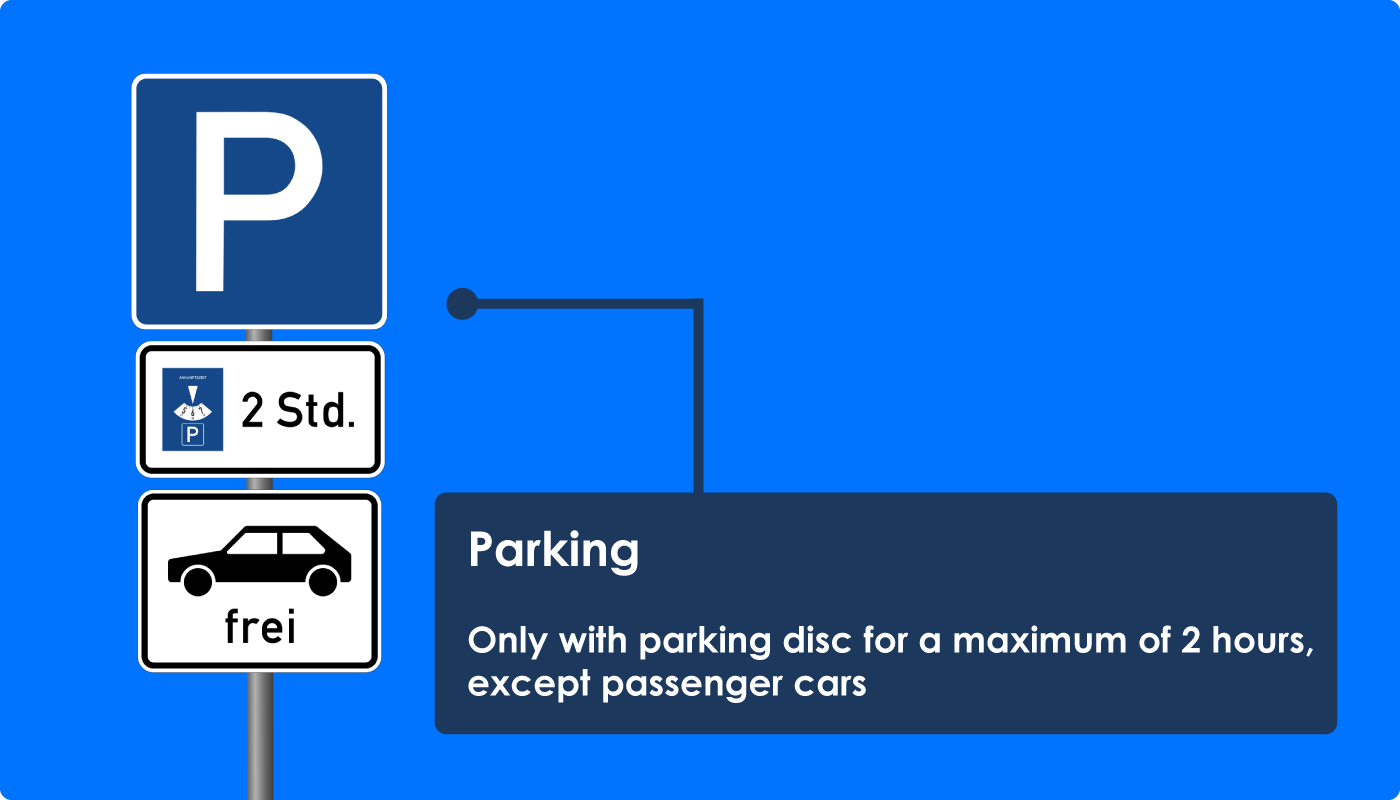
Here, passenger cars are exempt from the regulation.
Parking Only With Parking Disc, But Residents Free
Residents with a parking permit can also be exempt from the display of a parking disc (VwV-StVO on section 45, paragraph 1 to 1e).
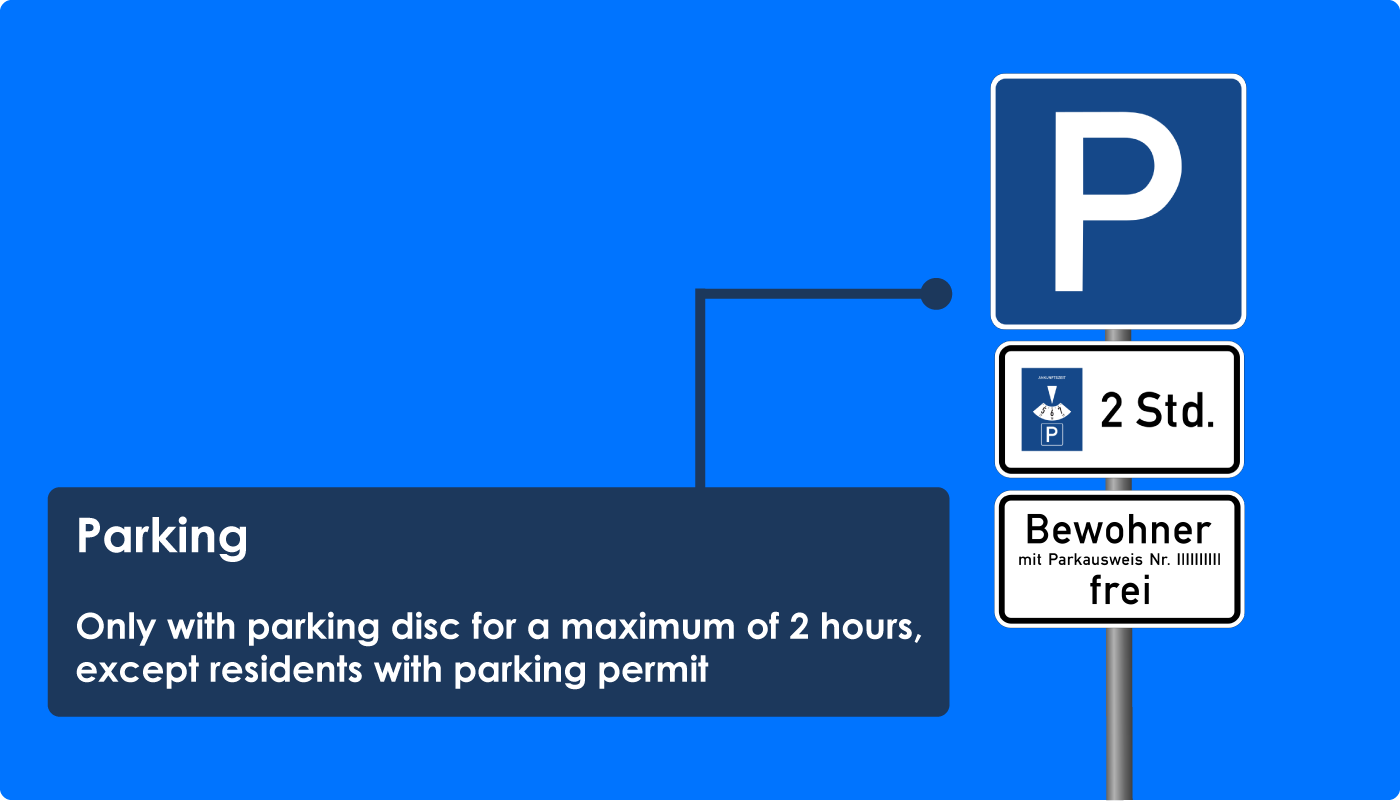
If parking spaces are signposted with the combination shown above, parking in the marked parking spaces is only permitted with a parking disc for a maximum of two hours.
Residents with the displayed parking permit may park indefinitely in the designated parking spaces, as they are not required to use a parking disc.
In some German streets, hard shoulders are marked with traffic sign 314 and the additional traffic sign “Parkscheibe … Std.” and “Bewohner mit Parkausweis Nr. … frei”. At the same time, “No stopping” traffic signs are also set up.
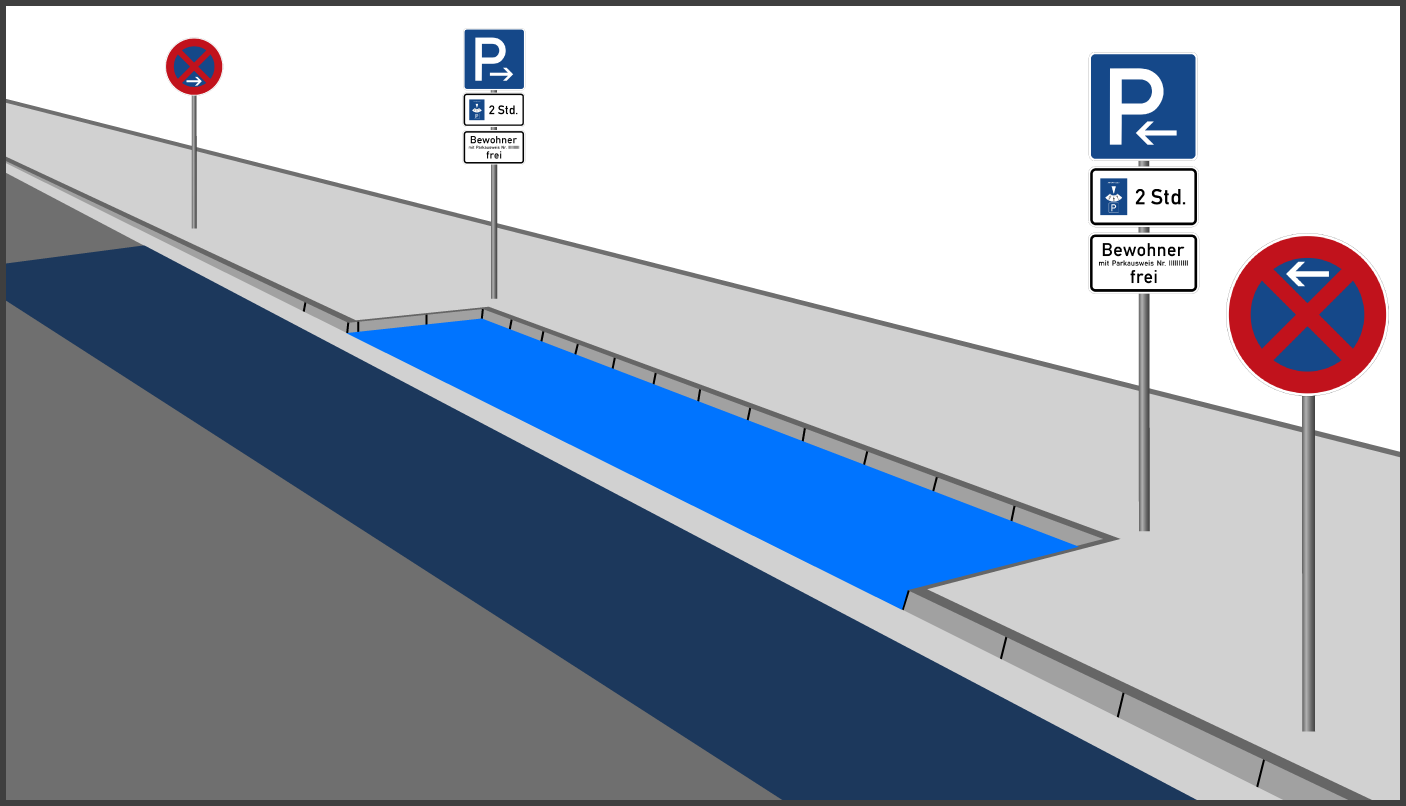
The traffic sign “Parken” indicates, among other things, parking permits on hard shoulders if permitted parking is restricted there by additional traffic signs (VwV-StVO on traffic sign 314).
On the illustration above, parking on the hard shoulder is limited to a maximum of two hours with the display of a parking disc. Residents are allowed unlimited parking on the hard shoulder.
The hard shoulder is shown above in light blue.
Without additional traffic signs, “No stopping” traffic signs prohibit stopping on the roadway (Annex 2 consecutive number 62 StVO).
The roadway is shown above in dark blue.
“No stopping” traffic signs do not apply to the hard shoulder at the picture above – that is to say, not to the light blue area.
Accordingly, the regulations of the traffic signs “Parking” and “No stopping” in the example above do not contradict each other, but regulate different parts of the road.
Parking Only With Parking Disc, But Electric Cars Free
Electrically powered vehicles can also be exempted from parking space management measures (VwV-StVO on section 45, paragraph 1g).
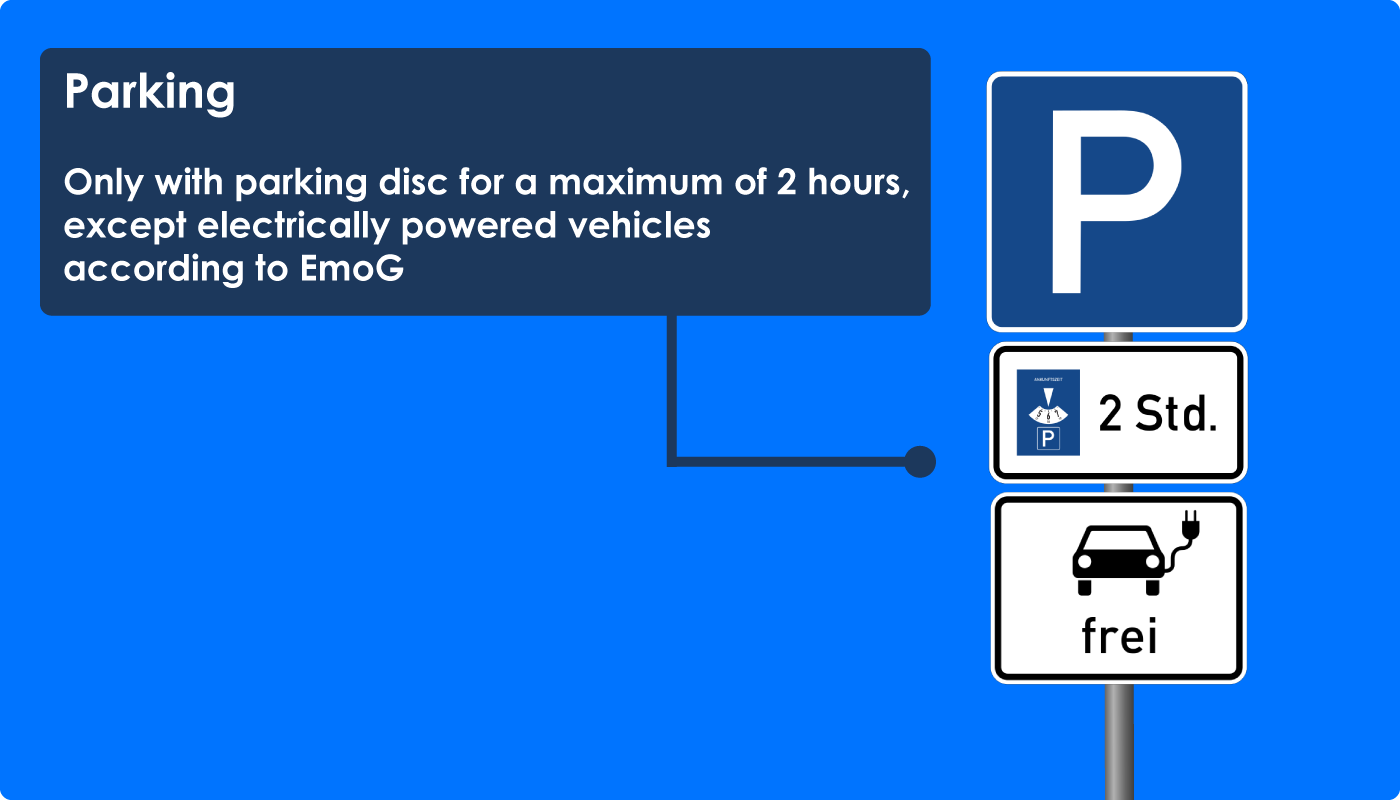
This is done with the additional traffic sign with the symbol “Elektrofahrzeuge” and the addition “frei”.
On the picture above, electrically powered vehicles according to the EmoG are exempted from having to display a parking disc.
Parking Only With Parking Ticket, But Electric Cars Free
Electrically powered vehicles according to EmoG can also be exempted from the parking ticket requirement.
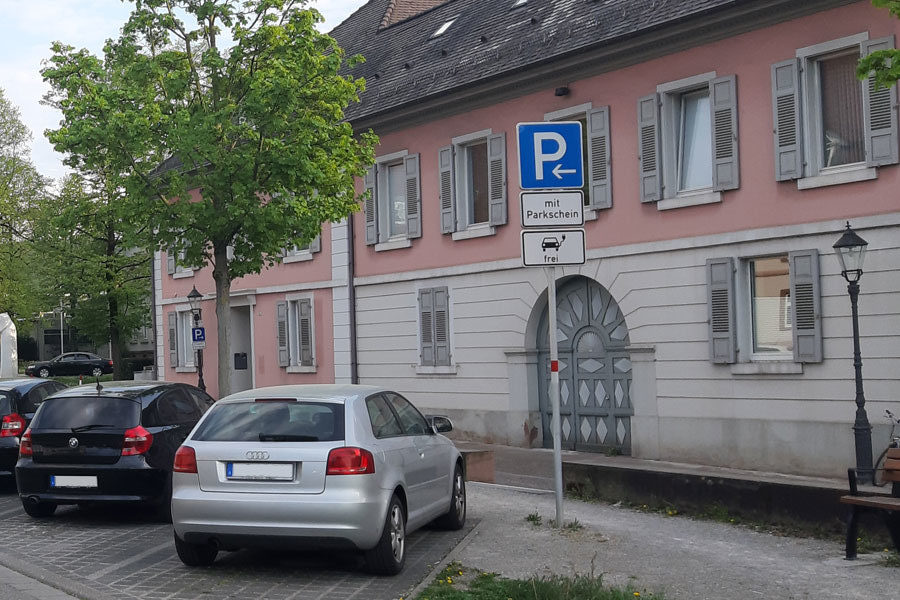
But remember: Electrically powered vehicles only mean vehicles with a number plate with an E.
If you drive an electrically powered vehicle without a number plate with an E, you must display a parking disc, use the parking meter or take a parking ticket.
Parking Only For Certain Car Sharing Companies
Parking can also only be allowed for one car sharing company (Annex 3 consecutive number 7 StVO).
The restriction to one car sharing company takes place through an additional specification of the corresponding company name in black letters on a white background on an additional traffic sign (Annex 3 consecutive number 7 StVO).
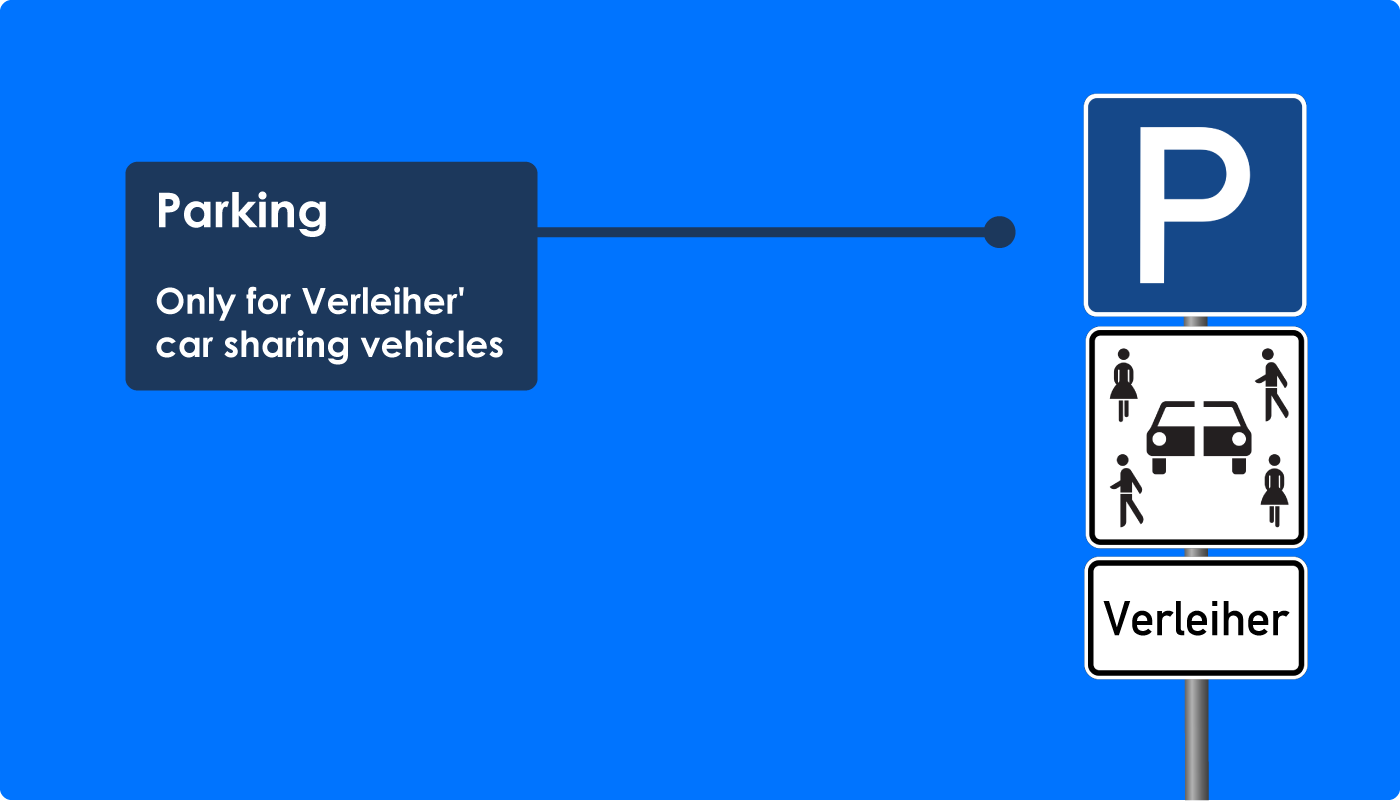
Restricting parking to certain car sharing companies is also permitted (Annex 3 consecutive number 7 StVO).
Parking is restricted to certain car sharing companies by means of an additional traffic signs with the corresponding company names in black letters on a white background (Annex 3 consecutive number 7 StVO).
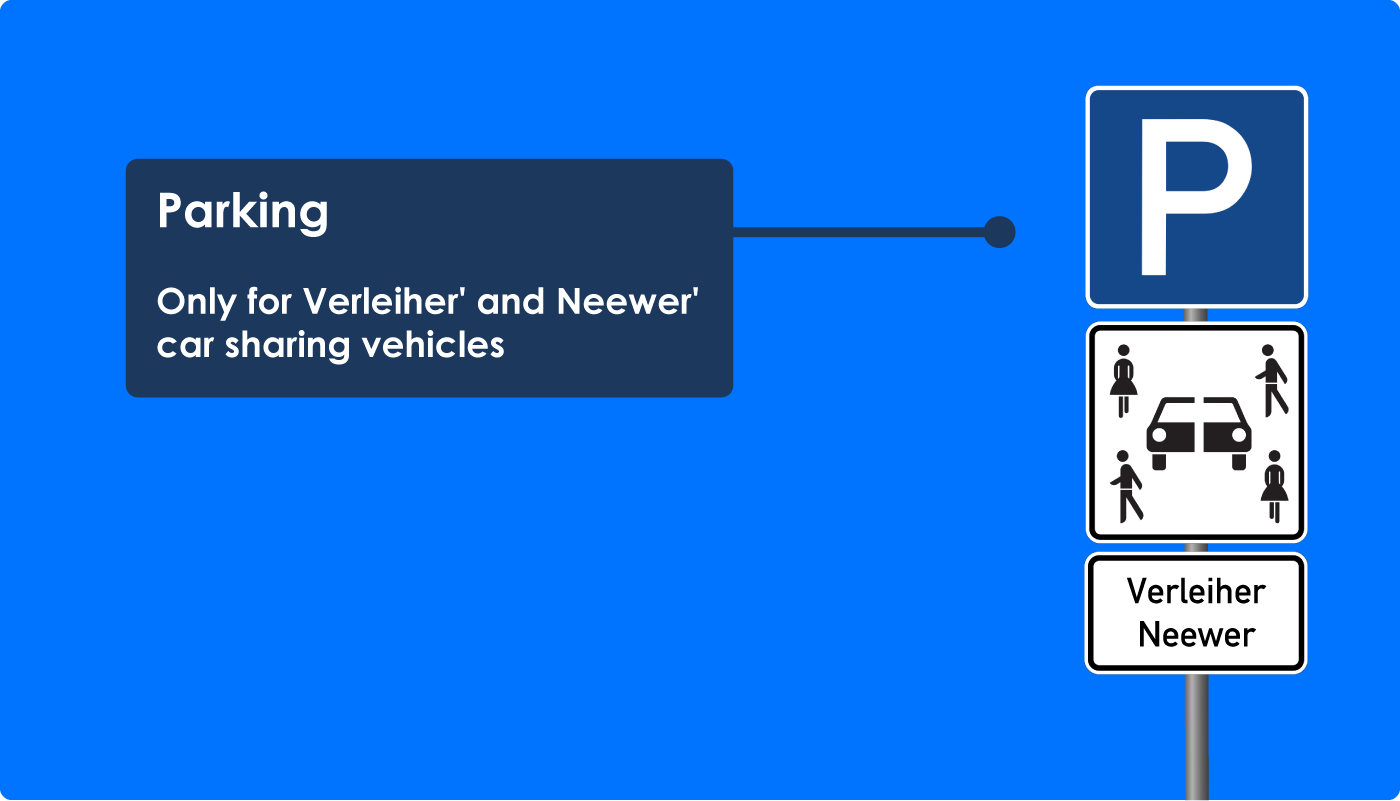
Both the restriction to just one car sharing company and the restriction to certain car sharing companies are based on the provisions of the Car-Sharing Act (Carsharinggesetz – CsgG).
Summary
If traffic sign 314 is placed together with an additional traffic sign with a black horizontal arrow, this indicates parking areas.
On the other hand, white arrows on traffic sign 314 indicate the beginning, continuation or end of parking areas.
Additional traffic signs with a certain time, certain weekdays or a parking disc under traffic sign 314 only allow you to park in the marked traffic areas for a specific time.
In addition to the obligation to use a parking disc, parking spaces can also be restricted to people with special parking permits. Parking spaces can be reserved for the severely disabled or residents with appropriate parking permits.
Additional traffic signs can also be used to restrict parking spaces to certain types of vehicles, such as passenger cars, buses, bicycles, cargo bikes or car sharing vehicles.
Did you like this article?

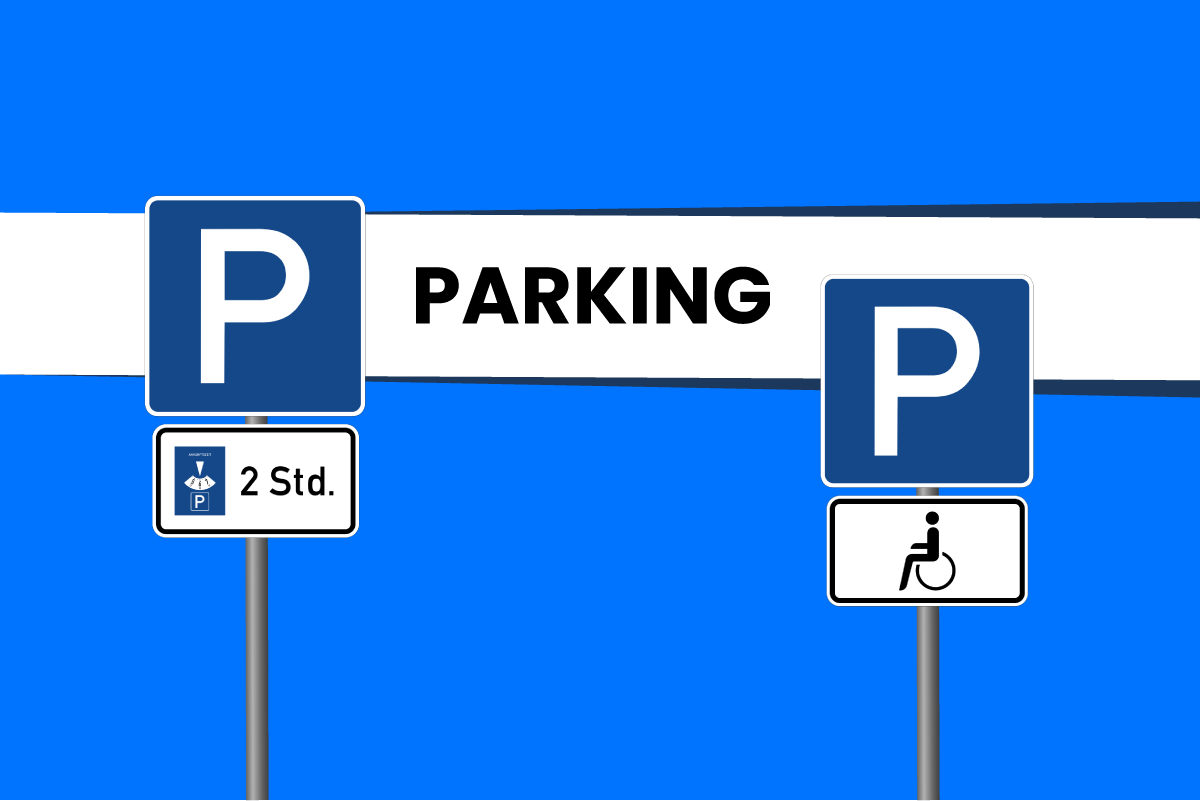

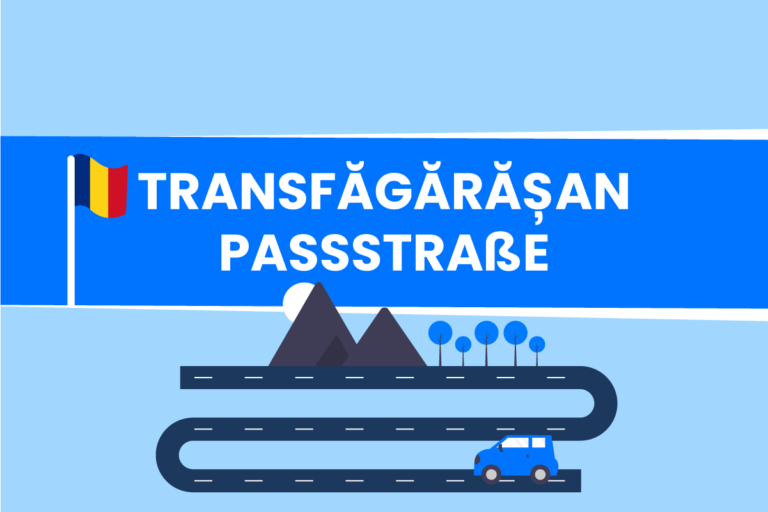
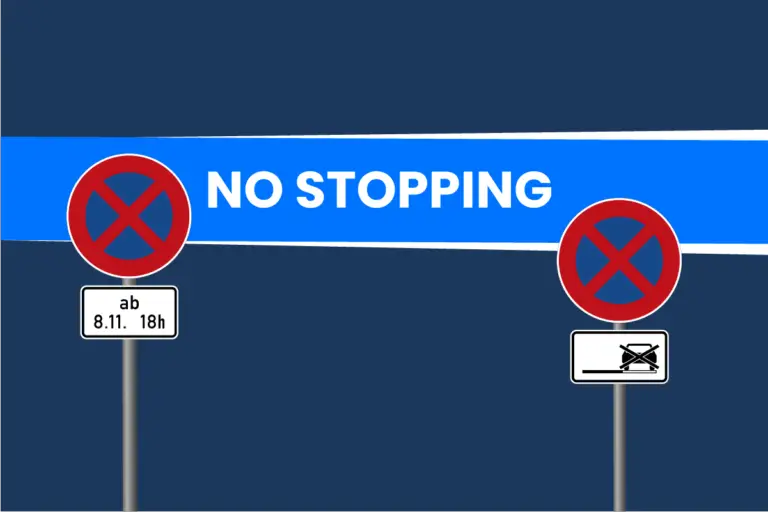
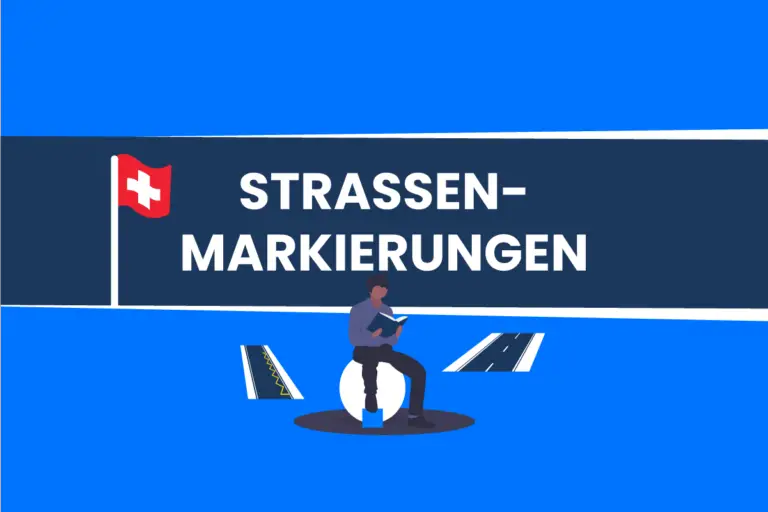
![Parkverbote in Frankreich erklärt [mit Bildern]](https://www.stvo2go.de/wp-content/uploads/parkverbote-frankreich-thumbnail-768x512.png)
